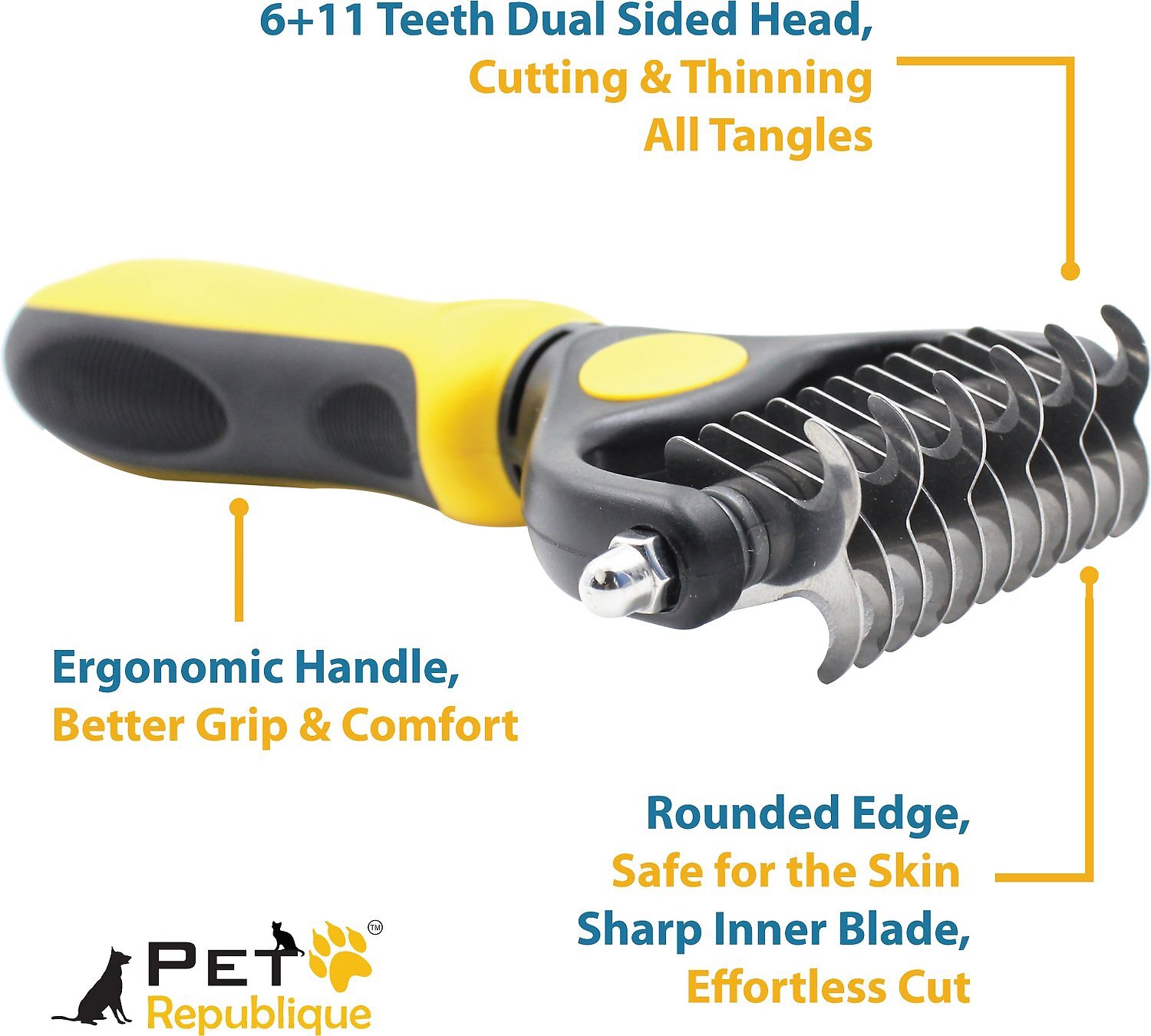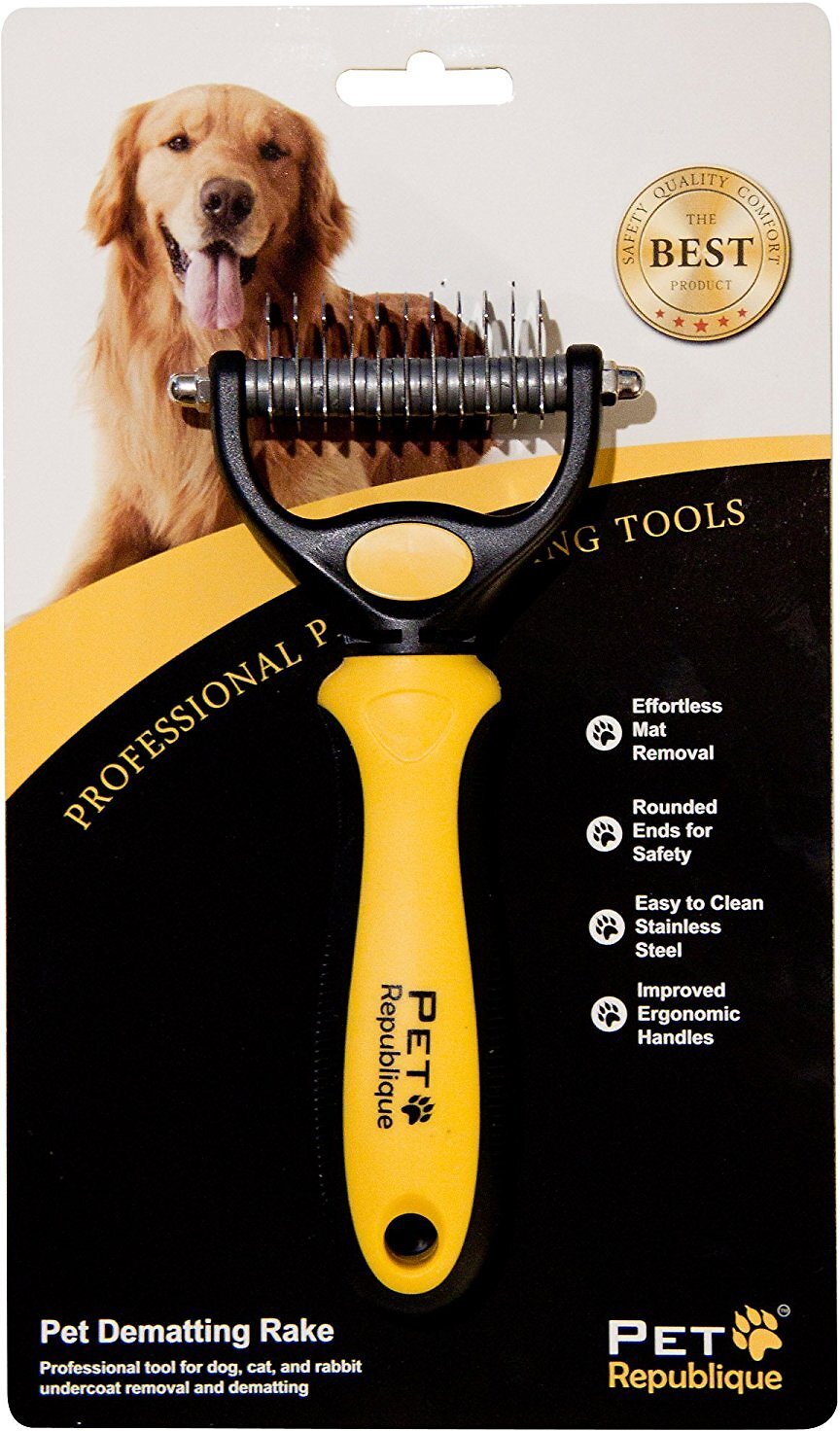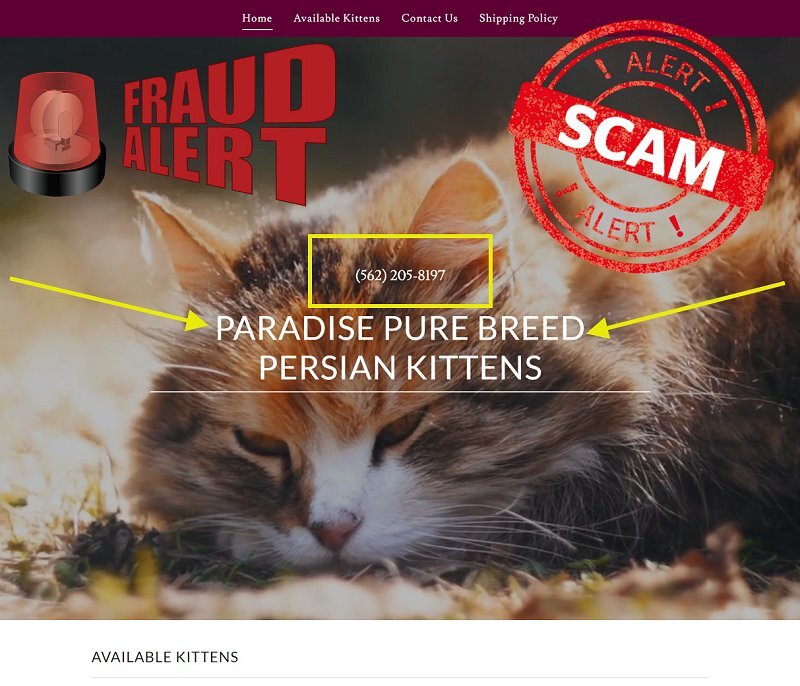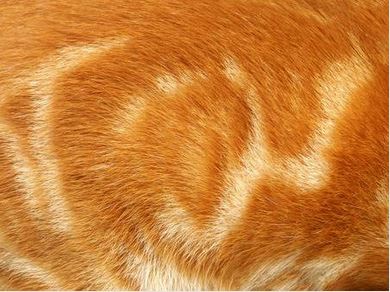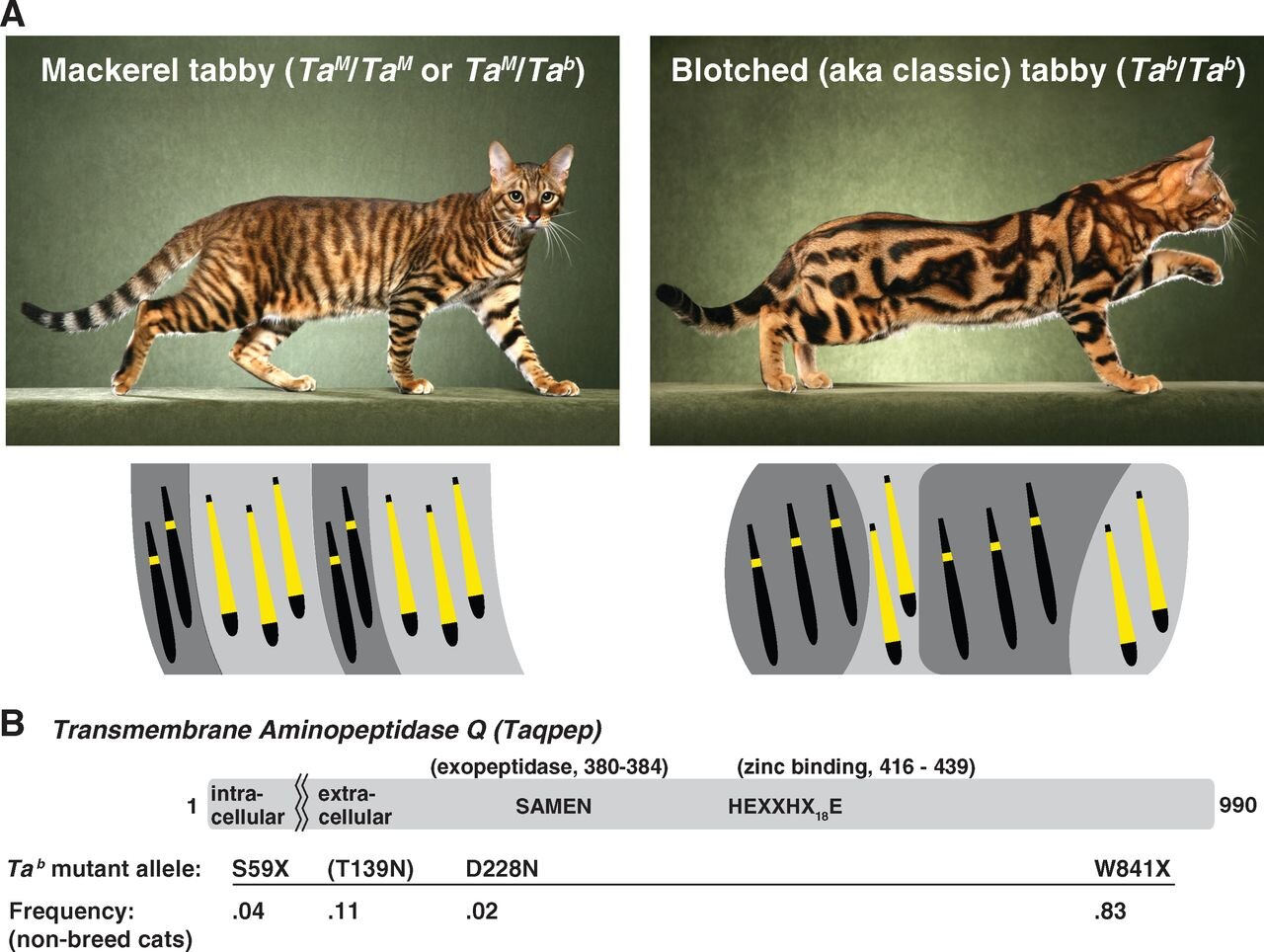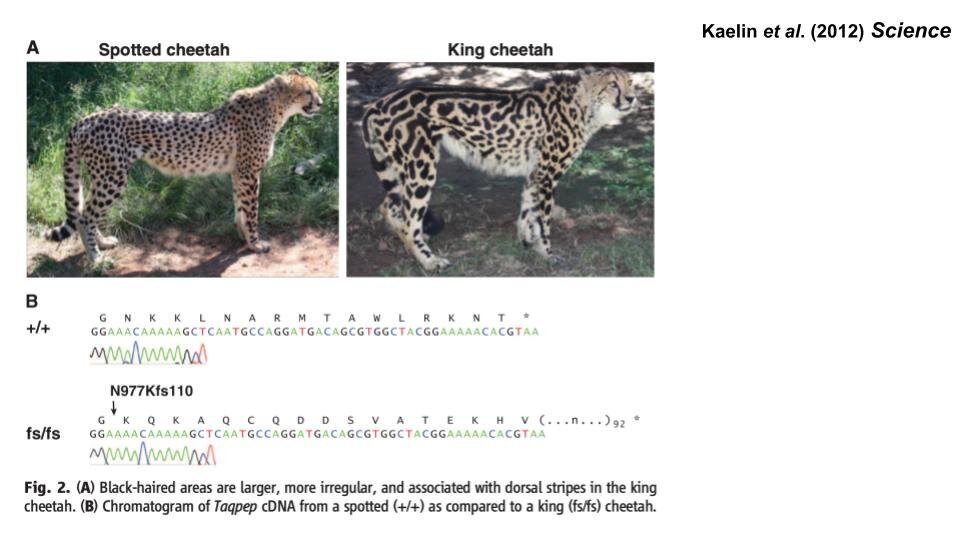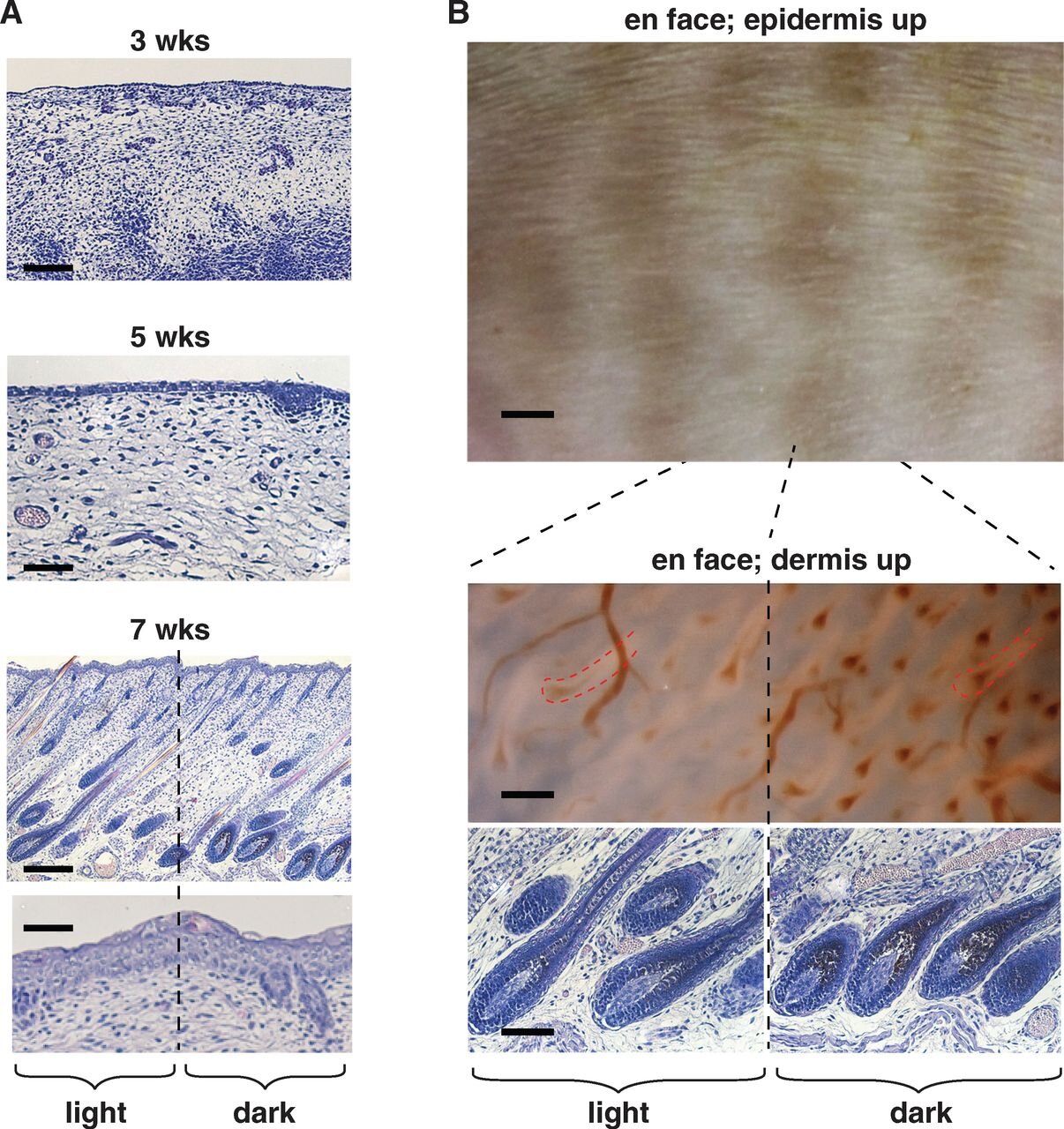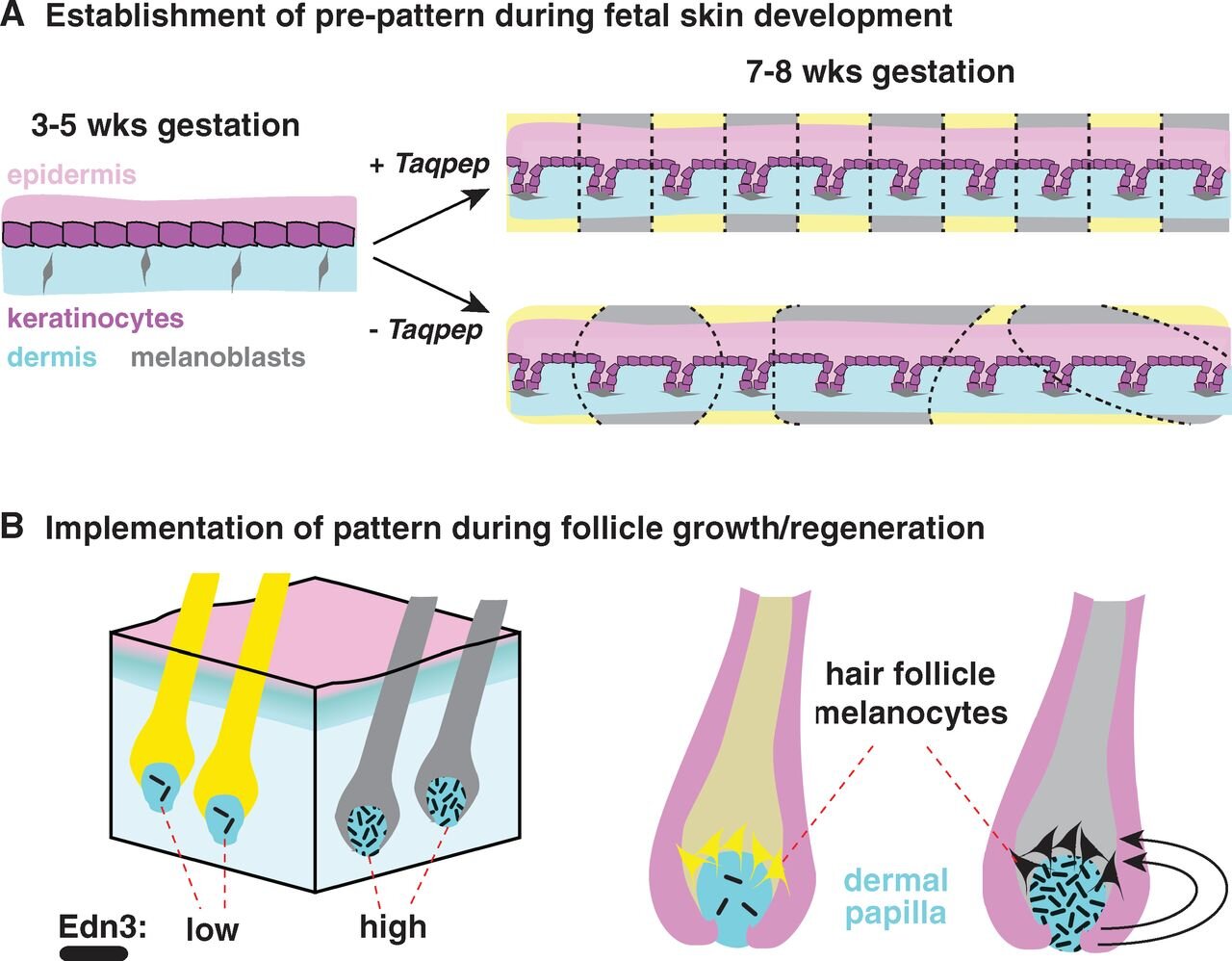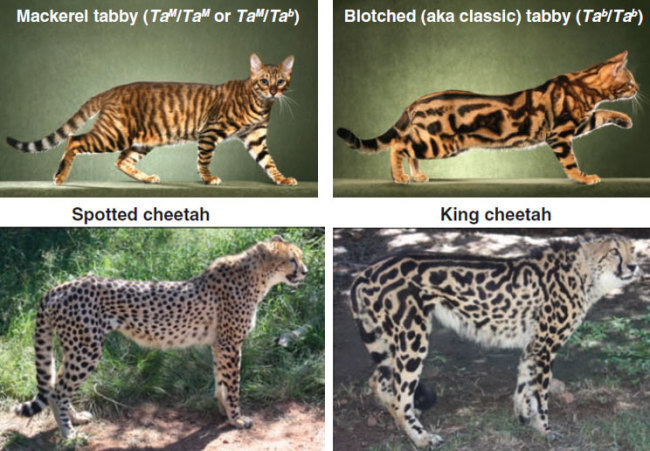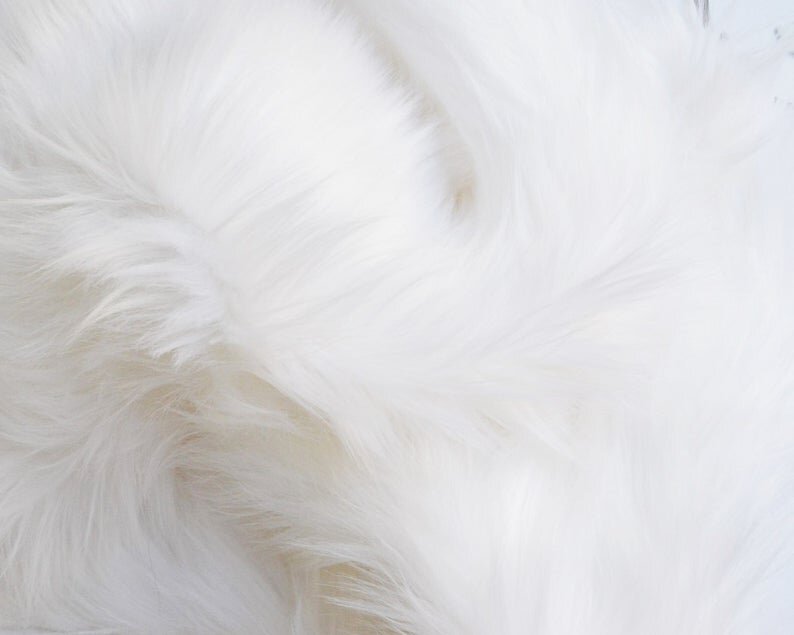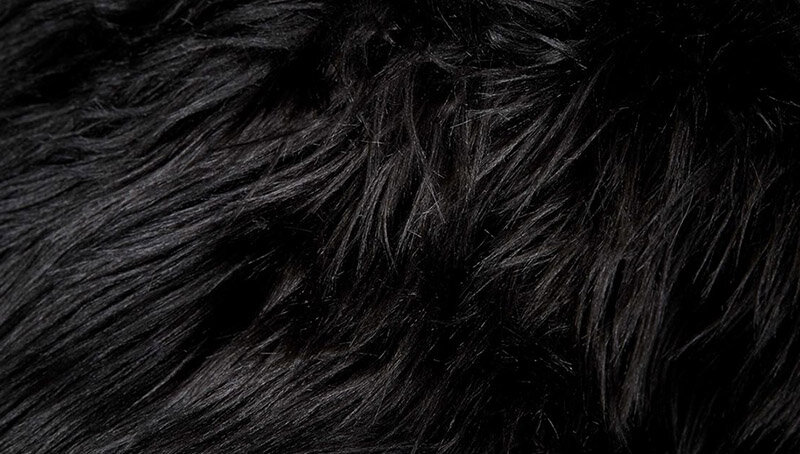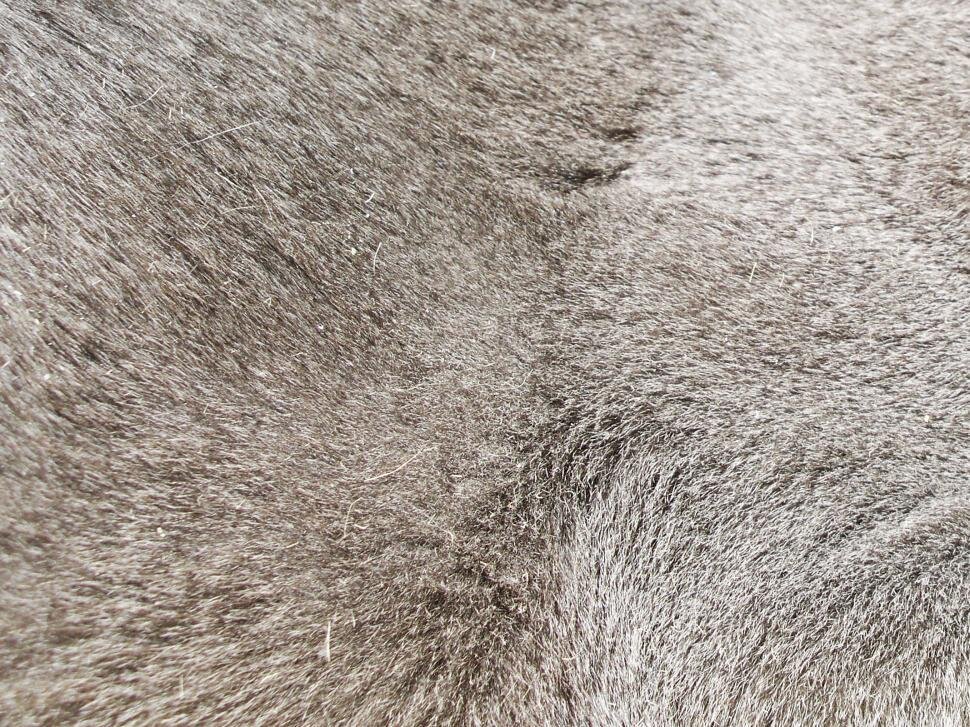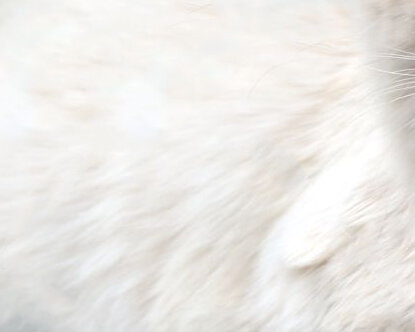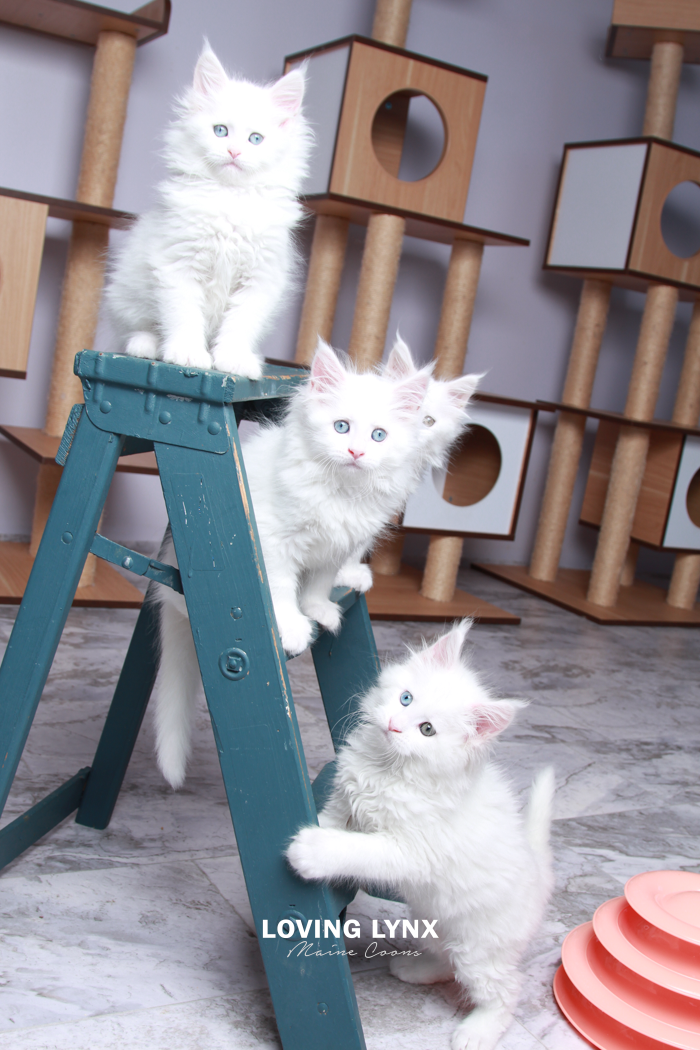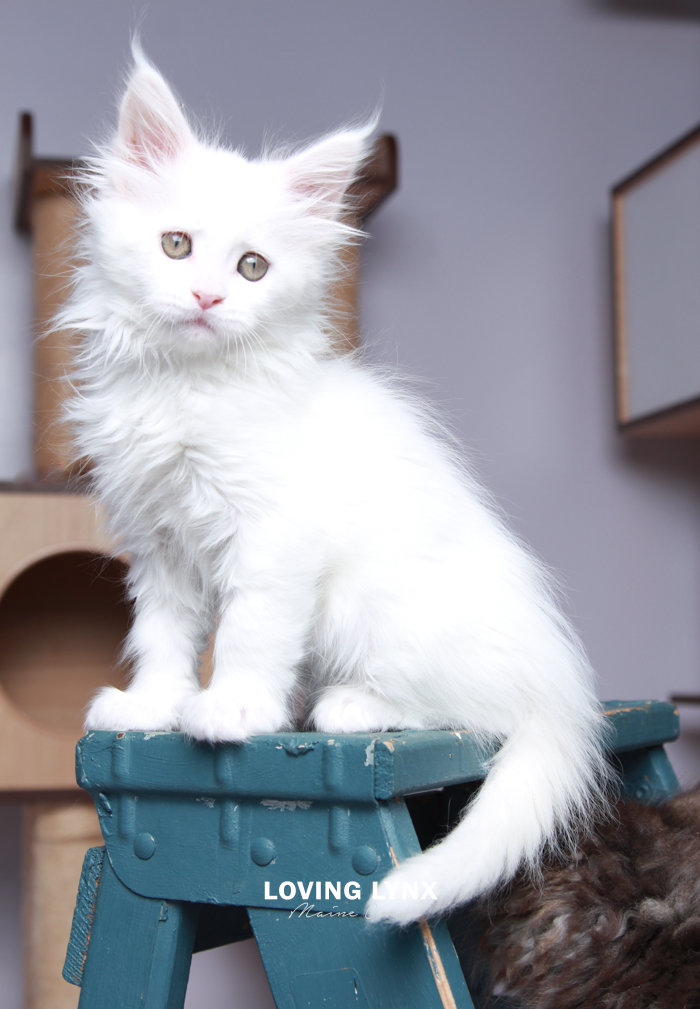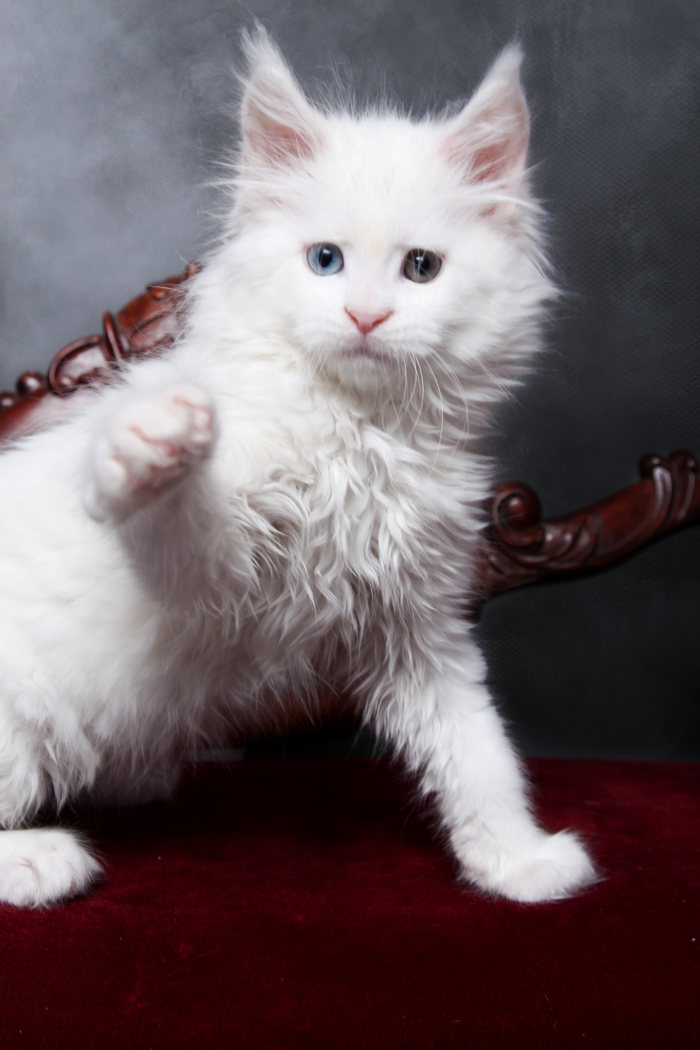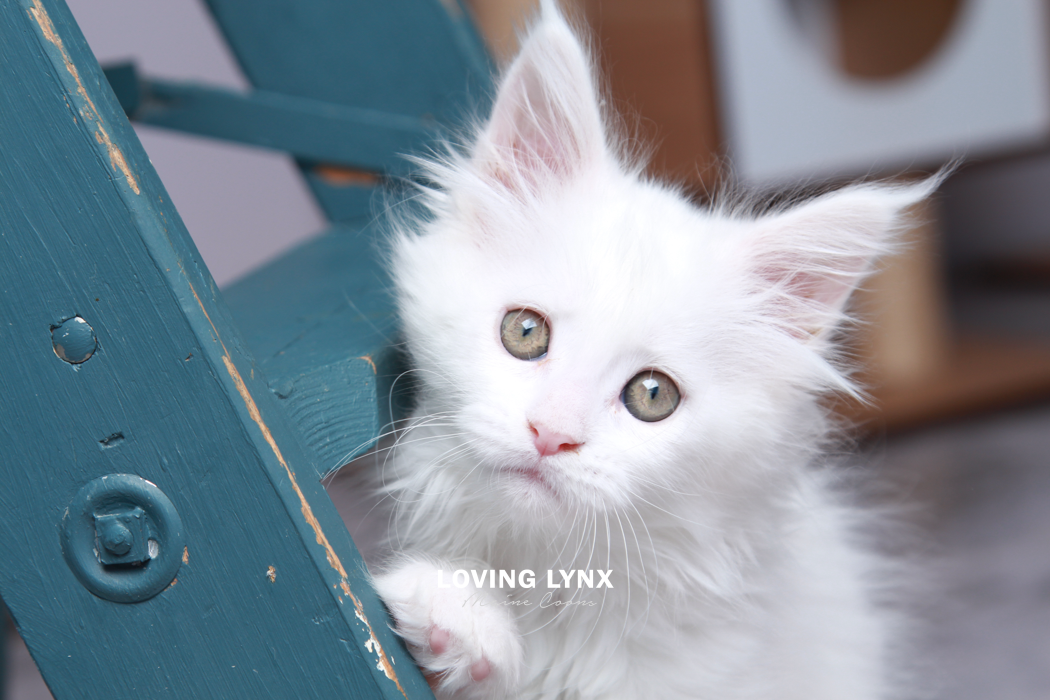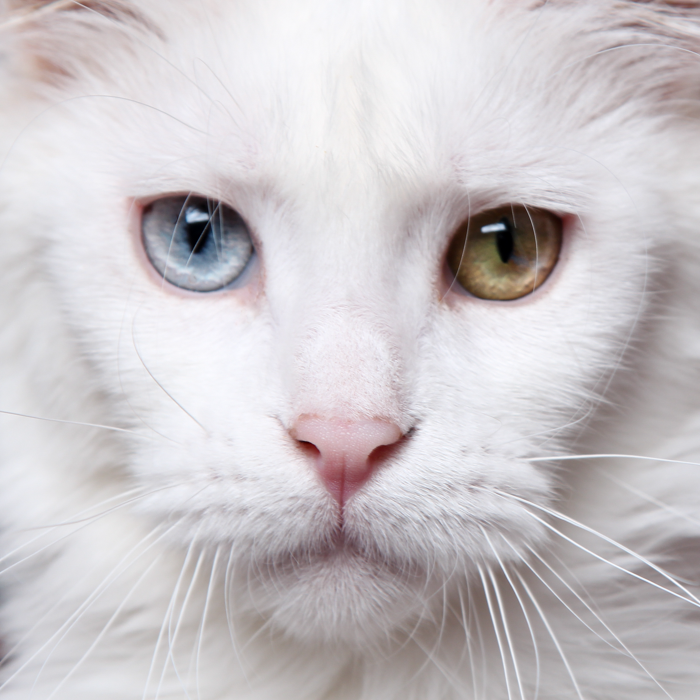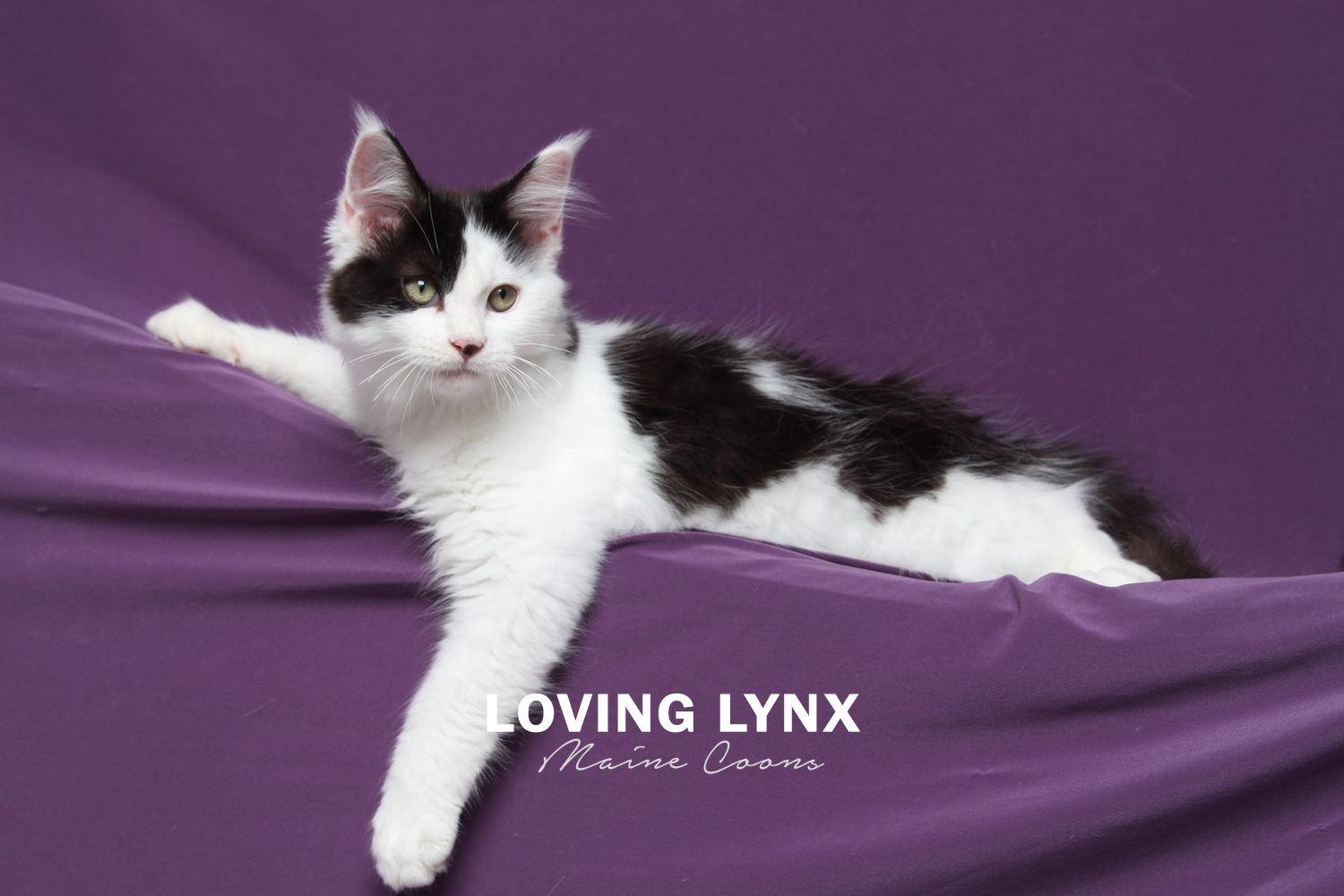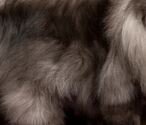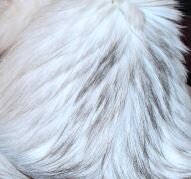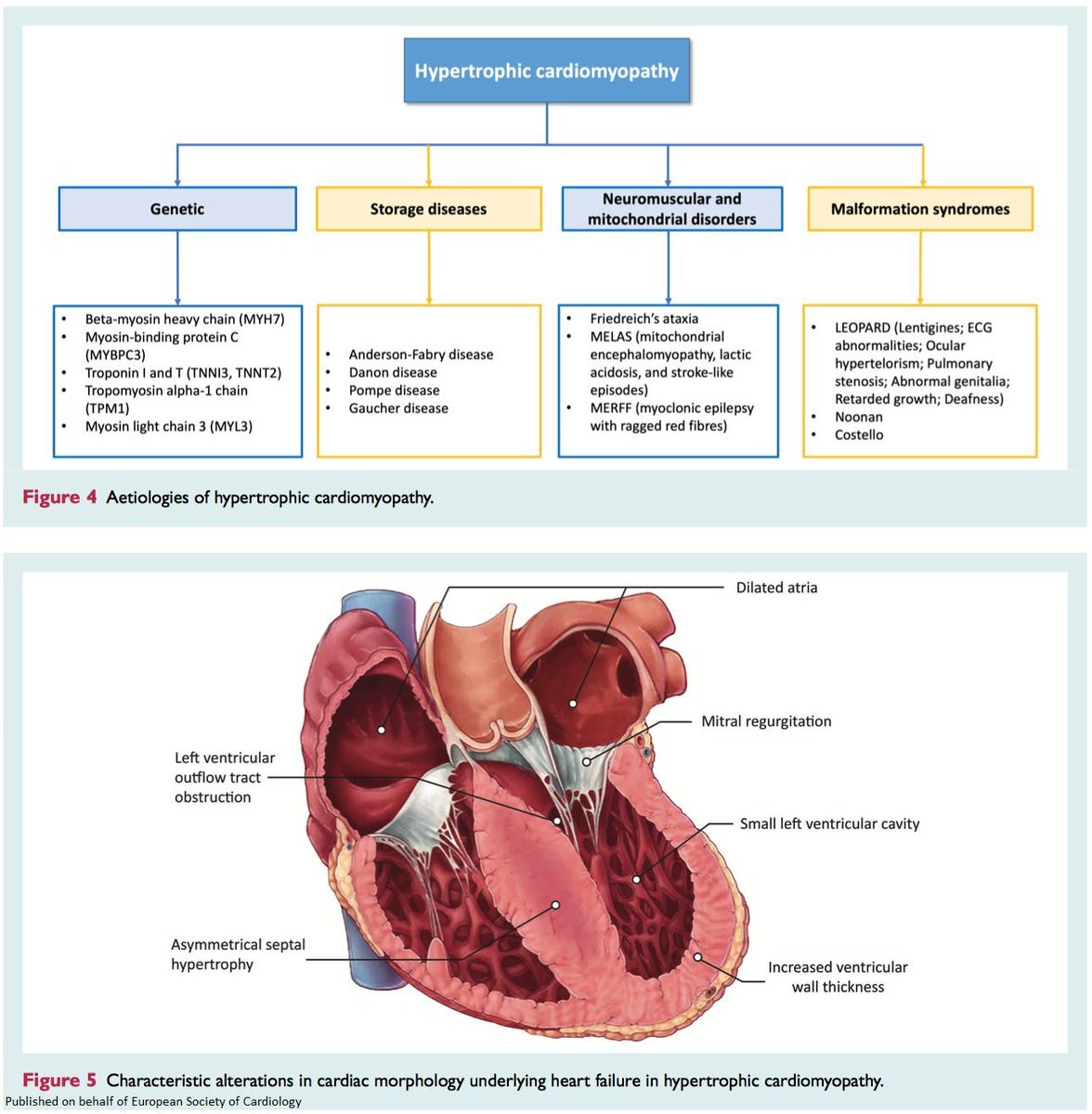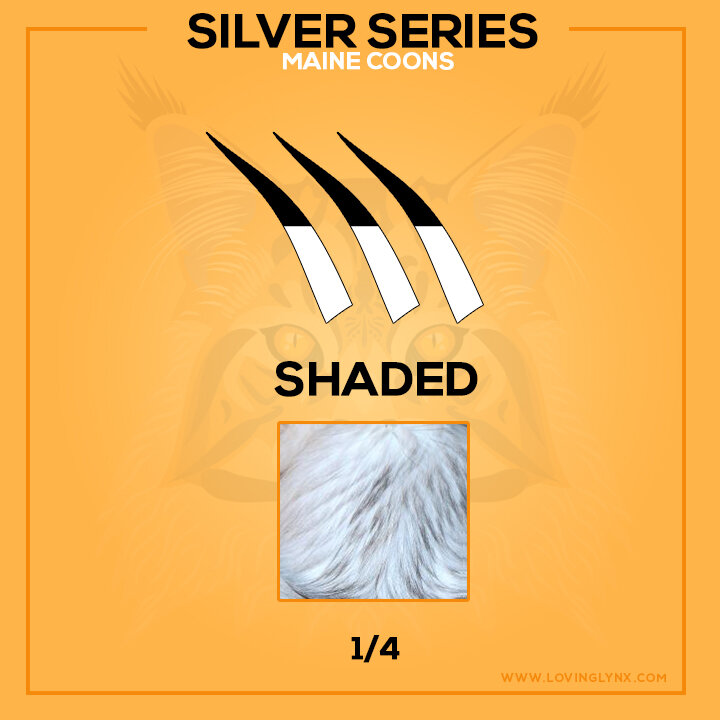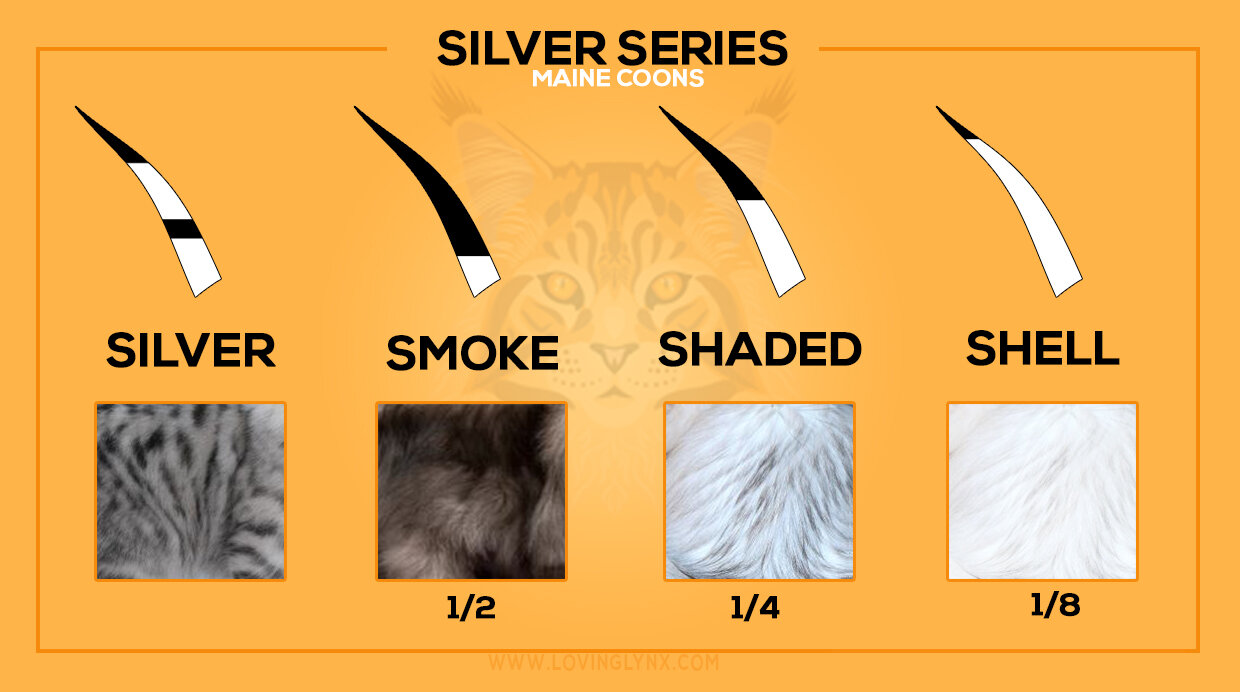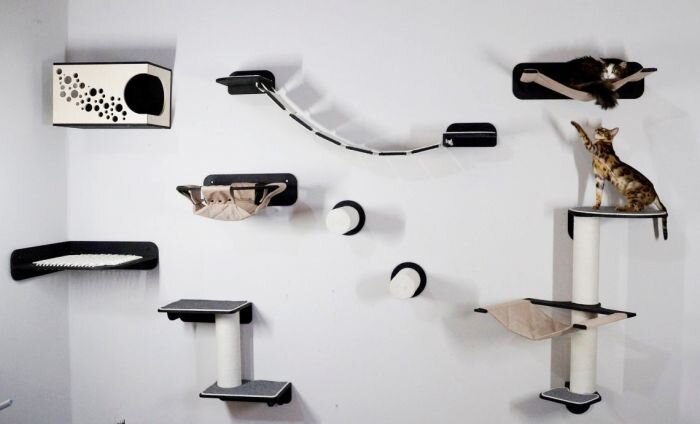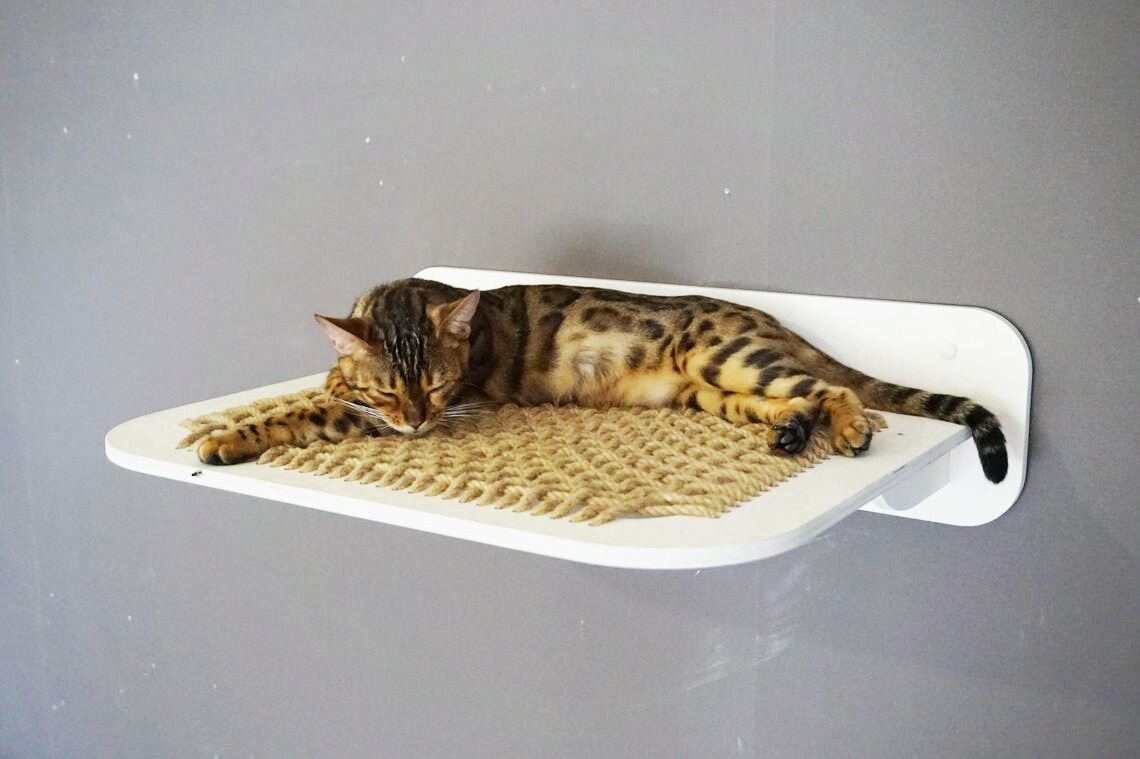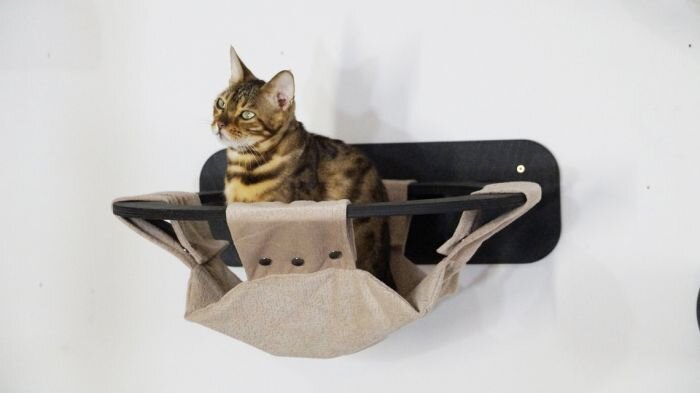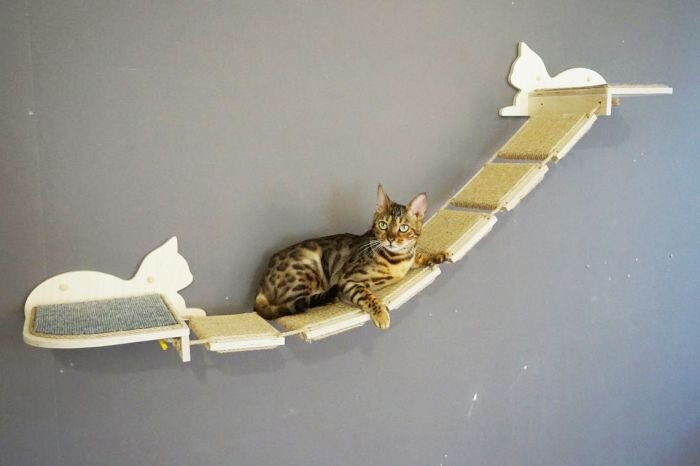Maine Coon Grooming
Properly grooming a Maine Coon depends on the fur texture, age, lifestyle and overall health. Some long coats never tangle, while others mat overnight.
Maine Coons do require grooming on a regular basis. The amount of grooming required will depend on the texture of the fur, age of the cat, lifestyle, and overall health. Some long coats almost never tangle, while others can become matted overnight. If your cat’s coat is prone to matting, daily brushing/combing may be necessary. Otherwise, about three times per week should suffice.
Grooming Tools
Grooming long-haired cats require some specialized tools. Most groomers recommend a wire slicker brush, an undercoat brush with a combination of wide and narrow teeth, a finer-toothed comb to go through the undercoat after you use the narrower brush, a flea comb for short-furred areas like the head, and a mat splitter. You may be able to substitute a letter opener like the one shown here for a mat splitter.
Metal combs: Metal combs have teeth that are far apart are good for keeping a dense undercoat from matting. Combs remove the harder to reach underfur.
Wire slicker brush: This flat, metal brush has small, fine wire bristles that are bent at an angle. Wire slickers will remove any loose top fur, not the undercoat.
Soft-bristled brush is good for removing dirt, debris, dead skin cells, and loose hair from your cat’s coat. It’s also nice to use at the end of a grooming session to distribute the oils through the coat, which makes it shiny and smooth.
Mat splitter: does just what it says. Sometimes mats are unavoidable no matter how much you groom your long-haired cat, and must be removed for good coat health.
Grooming TIPS
Start Grooming young
It’s best to start getting your cat acquainted with grooming at an early age. Professional groomers and breeders say you can begin grooming your kitten as young as eight weeks of age.
Build trust a little bit at a time
Not all long-haired cats get used to grooming as kittens, however, so you may still have a job in front of you when you begin grooming an adult cat. The good news is that while you’re acquainting her with the joy of a good brushing and combing, you can start easy. In the beginning, groom her back first. Cats tend to be less stressed when you’re not approaching vulnerable parts like the belly. Be sure to reward her patience with her favorite treats.
Be gentle when you find mats
Don’t tug on mats. It hurts and you may rip your cat’s delicate skin. Instead, use a mat splitter to cut the mat into smaller pieces, which you can then remove with a comb. I’ve also found that if you can grasp the hair by the roots and begin combing the mat out from the end of the hair, it relieves some of the pain of tugging and allows you to get the mat out a little bit at a time.
Do long-haired cats need haircuts?
The short answer is, no. Unless your cat has a matted coat, haircuts are unnecessary. Grooming your cat regularly is recommended by your veterinarian for your specific breed.
Deshedding Tool
Don’t want your Maine Coon to have so much fur? This comb will remove a significant portion, especially with regular usage. This dual-sided matt demolisher features 23 stainless-steel teeth designed to tear through even the densest of tangles. A non-slip ergonomic handle makes it a breeze to detangle your pet’s hair, while rounded edges serve to protect your little one’s sensitive skin from sharp blades. Plus, Pet Republique will donate 15% of all profits to the American Animal Rescue Society, so each purchase you make helps to save the life of a dog or cat in need.
Carding Buttercomb 4"
Strips undercoat like no other. Many slicker brushes have sharp ends that can scrape and damage a cat’s delicate skin. High-quality metal combs penetrate deeply into the coat to remove dead hair, knots, and tangles, without irritating the skin. Brushing a cat isn’t the best technique in removing shedding hair and undercoat, and a lot of the time it just adds static. Brushes do not reach down to the skin where the problem may be. But if you decide to brush the cat anyway, I recommend using a soft bristle brush versus a metal slicker brush. The slicker can scrape the cat’s skin so I don’t use them.
TIP: Best Maine Coon comb is a 10” long, 1 ½ inch tined greyhound comb
Slicker Brush
PRO TIP: Use a Slicker Brush to “brush” your cat trees! You heard me right, the easiest way to clean a carpeted cat tree is to first use a wire brush. It will pick up 90% of the hair.
My Favorite Shampoo
Bio-Groom Purrfect White! My only complaint is I can’t get a gallon jug! Smells amazing with amazing results!
Groomer’s Goop
The professional choice of groomers, breeders, and those who show their pets. It’s a great first step to ‘degrease’ the coats of Persian, Himalayan, and Maine Coon cats and long-haired dogs. Its enriched formula contains lanolin, glycerin, vitamin E, and aloe vera to better treat your animal’s skin. Groomer’s GOOP offers a complete line of pet de-greasers, shampoos, conditioners, rinse-free shampoo wipes, plus leave-in conditioning spray and coat freshening spray.
Lion Cut
Cats can get lion cuts whether they are long or short-haired. The most common reason for a lion cut is matting. If a cat is already matted, the best and most humane option is to shave the cat into a lion cut, then get the cat on a regular grooming schedule to prevent matting. Cats should not be cut with anything smaller than a #10 blade (1.5mm).
TIP: If you use a 9.5MM blade on the clippers you will get a non-buzzed/shaved appearance. Instead, the hair will be slightly longer. Many groomers will use a smaller blade resulting in an unappealing super short haircut. Remember to ask for a blended transition if you prefer less abrupt sections.
Lion Cut Maine Coon using 2.5MM blade. (via mammamia_s)
Grooming Spray Video
Grooming Warnings
Maine Coon Diet
Cats are obligate carnivores, which means that they rely on nutrients found only in animal products. Cats evolved as hunters that consume prey that contains high amounts of protein, moderate amounts of fat, and a minimal amount of carbohydrates, and their diet still requires these general proportions today. Cats also require more than a dozen other nutrients, including vitamins, minerals, fatty acids, and amino acids. Their systems are set up to metabolize a natural diet high in moisture, high in protein and very low in carbohydrates.
The Feline Diet, What do cats really need?
Maine Coons like all cats are obligate carnivores. This means that they rely on nutrients found only in animal products. Cats evolved as hunters that consume prey that contains high amounts of protein, moderate amounts of fat, and a minimal amount of carbohydrates, and their diet still requires these general proportions today. Cats also require more than a dozen other nutrients, including vitamins, minerals, fatty acids, and amino acids. Their systems are set up to metabolize a natural diet high in moisture, high in protein, and very low in carbohydrates.
Cats have no dietary need for carbohydrates, carbs are processed and stored as fat. A carb-heavy diet will stress the cat’s digestive system and reduce the efficiency of protein absorption. If the diet does not contain enough animal protein for their daily needs, or they are unable to process an adequate amount of that protein, cats will sabotage the muscles in their own bodies to obtain their daily needs. Additionally, feline satiety is signaled by the ingestion of sufficient amounts of animal protein in their food; lacking it, they will consistently overeat, resulting in yet more carbs being converted to fat.
Cats are unable to synthesize eleven different amino acids; arginine, histidine, isoleucine, leucine, lysine, methionine, phenylalanine, threonine, tryptophan, valine, and, taurine. Cats also can not synthesize vitamin A, vitamin D, and the fatty acid arachidonic. Cats can create niacin but insufficient to their needs so they must consume niacin daily.
What are we feeding our kittens?
Dry Food
Royal Canin Spayed & Neutered Kitten - Left out at all times (24/7).
Royal Canin Ragdoll Adult Cat Food - Left out at all times (24/7).
Daily Wet Treat
1 can of Friskies mixed with 1/2 cup of dry food.
DUE TO AVIAN FLU WE ARE NOT FEEDING RAW - We feed kittens a properly balanced raw diet once a day. Providing a balanced raw diet is key otherwise raw is not a healthier option. Raw is the healthiest option for your cat. We buy prepackaged “Ground Chicken From HARE-TODAY”. This is a whole diet that you can serve, you can add Friskies canned for picky cats.
Immunity Support
Tomlyn Immune Support L-Lysine Powder Cat Supplement is a veterinarian-formulated supplement that supports your cat’s immune system, and respiratory and eye health. Taste tested and loved by cats and kittens, safe and effective for cats of all ages. Especially good for kittens going to a new home and dealing with the stress of relocation. Our vet turned us on to the supplement and we find it fantastic.
What do our breeding cats eat?
My females are on a premium diet formulated by Royal Canin. The start on Royal Canin Queen Formula while in heat, gestation and birth of kittens. They are then moved onto Royal Canin Baby Cat Formula for lactation and weaning of kittens, this formula is very small size and nutrient dense . Then they are transferred onto Royal Canin Kitten Formula. From then the queens go back onto Royal Canin Queen Formula.
How to pick a cat food brand?
Seek brands that have an AAFCO-approved nutritional guarantee and adherence to WSAVA guidelines. Avoid canned foods containing peas, lentils, other legume seeds, or potatoes as the main ingredients. Limited grain content is ok this includes corn and rice.
What is the WSAVA?
The World Small Animal Veterinary Association is an international group of over 200,000 veterinary professionals. Their mission is to “advance the health and welfare of companion animals worldwide through an educated, committed, and collaborative global community of veterinary peers.”
WSAVA Guidelines
Evidence of scientific formulation
Extensive testing
Quality control by manufacturing their own foods.
Research to meet long-term nutritional needs and subject this research to a peer-review process.
What to avoid in cat foods?
Avoid a “BEG” diet (Boutique brands, Exotic ingredients, Grain replaced with pulse).
Boutique brands - A boutique brand is one made by a pet food manufacturer who does not employ an appropriately qualified team of experts to study and formulate their diets. These companies often rely on marketing trends rather than testing and nutritional research.
Exotic ingredients- These are ingredients not classically found in pet foods and consist of animal proteins such as kangaroo, buffalo/bison, ostrich, alligator, duck, lamb, salmon, venison, and rabbit.
Grain replaced with pulse- Traditional grains have been replaced with pulse ingredients (legume seeds such as peas, lentils, various beans, and chickpeas) and it is these pulse ingredients that are currently thought to be a major contributor to the development of NM-DCM. *
Raw Cat Food
DUE TO AVIAN FLU WE ARE NOT FEEDING RAW
We suggest feeding Maine Coons a properly balanced raw diet. Properly balanced raw is the healthiest option for your cat. Providing a ***balanced*** raw diet is key, otherwise raw is not the healthier option. Cats fed a balanced raw diet have a higher muscle mass (weighing more), a healthier coat, lower risk for certain diseases, and have a longer life expectancy. Providing a balanced raw diet is key otherwise raw is not a healthier option. Switching to raw should not upset your cat’s stomach. We buy prepackaged (Ground chicken bones & organs) from HARE TODAY (https://hare-today.com/)
Feeding a properly balanced raw diet is the best species-appropriate diet possible. Raw is the cheapest option per pound but requires the most planning. Kittens should be fed as much raw as they want twice a day till 1.5-2 years of age. Adults consume 3%-6% of their body weight in raw but can eat more (Some cats simply burn more energy). If you are concerned your cat is not eating the correct amount please consult your veterinarian, a veterinarian should be able to do a physical exam to assess body condition.
Feline Nutrition Foundation Quote
“A balanced raw diet includes flesh, organs, a bone or ground bone, and a small amount of vegetation. Most people try to feed meats that are close to what cats would naturally be eating, so meat such as beef, which can cause allergic reactions in some cats, lamb, and pork are used less often. Fish should be avoided except for occasional use for many reasons including heavy metal contamination, vitamin E depletion, and the fact that cats get addicted to it because of its strong taste. Raw cat food diets try to balance the meat to bone ratio to match that of a wild diet, usually mouse or rabbit. This balances the calcium to phosphorus ratio. Cats cannot live on meat alone. Their calcium source is ideally from bone, not a supplement, as bone provides other minerals such as copper and zinc, along with collagen. Rawbone is highly digestible and provides calcium, minerals, and enzymes. The marrow is nutrient-rich. It is only cooked bone that is dangerous.”
DIY Raw Cat Food
https://feline-nutrition.org/nutrition/making-raw-cat-food-for-do-it-yourselfers
“A balanced raw diet includes flesh, organs, a bone or ground bone and a small amount of vegetation. Most people try to feed meats that are close to what cats would naturally be eating, so meat such as beef, which can cause allergic reactions in some cats, lamb, and pork are used less often. Fish should be avoided except for occasional use for many reasons including heavy metal contamination, vitamin E depletion and the fact that cats get addicted to it because of its strong taste. Raw cat food diets try to balance the meat to bone ratio to match that of a wild diet, usually mouse or rabbit. This balances the calcium to phosphorus ratio. Cats cannot live on meat alone. Their calcium source is ideally from bone, not a supplement, as bone provides other minerals such as copper and zinc, along with collagen. Raw bone is highly digestible and provides calcium, minerals and enzymes. The marrow is nutrient rich. It is only cooked bone that is dangerous.”
“Canned cat food has a moisture content of at least 75 percent, making it a good dietary source of water. Water is essential for chemical reactions in the body, temperature regulation and joint health and mobility. It makes up about 60 percent of your cat’s body, so it’s vital to maintain proper hydration through adequate water intake. Canned foods for cats are often higher in protein and lower in carbohydrate than most dry diets. Because of the water, they are also lower in calories per volume and the cans offer built-in portion control versus having a whole bag of dry food. Many of the newer canned cat foods are very high in moisture – some as high as 85%, and this can make these diets much more expensive to feed than dry diets or lower moisture diets, which may be a consideration for some cat owners.”
FDA WARNING (Stop Grain Free)
What is the FDA DCM Report?
June 2019, The U.S. Food and Drug Administration (FDA) is alerting pet owners and veterinary professionals about reports of feline and canine Dilated Cardiomyopathy (DCM) eating certain pet foods containing peas, lentils, other legume seeds, or potatoes as main ingredients. DCM is occurring in breeds not genetically prone to the disease. Animals with DCM respond to medication and supplementation regimens. DCM can lead to congestive heart failure.
What is causing DCM?
Nutritional DCM is thought to be caused by a deficiency or malabsorption earlier in the amino acid pathway, where the cat/dog should be accessing the cysteine and methionine in the foods, or it's a leaching/binding of the taurine in the cat or dog's body by the fiber in legumes and pulses, or both. All pet food companies have had low levels of DCM cases, it is the surge in DCM cases that has raised alarm. For example; Diamond is significantly smaller than Hills and Diamond has 117 cases confirmed by the FDA. Hills has 3 cases confirmed limited only to their grain-free diets. Plant protein in legumes (non-grain) is much higher than grains so, it is difficult to know amount of meat protein vs. plant protein in a food. Lower total meat protein alongside the higher FIBER content of the non-grain ingredients could be an interesting area to investigate.
Can I supplement taurine?
Supplementing taurine to a grain free diet will not work because something in the diet is prevent absorption. Taurine is prevalent in hard-working muscle meats like thigh and shoulder meat, tongue and especially heart as well as whole prey and sardines. All powdered taurine is artificial and made in a laboratory. Most taurine is also sourced from China who is not only the number one exporter but also owns 40 manufacturers of taurine. Considering only 1-3% of imported items are inspected by the US and China has a history of contaminated product. We STRONGLY advise giving fresh (not frozen) raw hard working muscle meats once a week.
Quote: Jean Dodds, DVM Hemopet / NutriScan
“What we suggest you do, if you are concerned, is to have your veterinarian take a blood sample to measure the methionine, cysteine and taurine levels in both whole blood and plasma, and send it to a diagnostic laboratory experienced with the appropriate reference ranges for circulating taurine. If the levels are lower than normal for dogs, please discuss the appropriate next steps with your veterinarian. As well, please send the information on your dog, including the food you are feeding, breed, health regarding CHD and retinal degradation, age and weight to the FDA no matter what the results are. You and your dog would potentially be helping millions of other dogs. We are advocates for home-prepared food. However, we agree that the recipes used may not meet the minimum AAFCO nutrient requirements. If you do choose to go that route, please work with a veterinary or animal nutritionist who has a degree and experience in animal nutrition. As more research is completed, AAFCO may need to adjust their minimum nutrient requirements and add more optimal requirements so that foods can be more appropriately formulated for breed type, size and age. In our view, neither a balanced raw nor cooked diet is inherently “better” than the other. We work with many dogs that thrive on raw food diets, and others that do less well on raw foods but thrive on freshly prepared cooked foods. As we keep coming back to, every dog is an individual, and we believe that individual needs should outweigh a devotion to any one way of feeding.”
Quote: Lisa M. Freeman, DVM, PhD, DACVN
“The apparent link between BEG diets and DCM may be due to ingredients used to replace grains in grain-free diets, such as lentils or chickpeas, but also may be due to other common ingredients commonly found in BEG diets, such as exotic meats, vegetables, and fruits. In addition, not all pet food manufacturers have the same level of nutritional expertise and quality control, and this variability could introduce potential issues with some products. In our hospital, we currently measure taurine in all dogs with DCM, but more than 90% of our patients with DCM in which taurine has been measured have normal levels (and the majority are eating BEG diets). Yet some of these dogs with DCM and normal taurine levels improve when their diets are changed. This suggests that there’s something else playing a role in most cases – either a deficiency of a different nutrient or even toxicity that may be associated with BEG diets. Giving taurine is unlikely to prevent DCM unless your dog has taurine deficiency.”
2020 DCM UPDATE
Evidence is showing that if caught soon enough animals can be treated with medication and supplementation. Some cases have reported with evidence a partial or full recovery in under a year.
DCM Resource Links
Dr. Jean Dodds Responds To FDA Statement
It’s Not Just Grain-Free: An Update on Diet-Associated Dilated Cardiomyopathy
FDA Notice: Potential Link Between Certain Diets and Canine Dilated Cardiomyopathy (DCM)
https://www.fda.gov/animal-veterinary/news-events/fda-investigation-potential-link-between-certain-diets-and-canine-dilated-cardiomyopathy?fbclid=IwAR3uCOveCBfW5uF-uPSs16HOPLOBDxGQAblneCrMaSGsaydsitiDzA7jdxU#vet-LIRN
Q/A on FDA Possible Connection Between Diet and DCM
https://www.fda.gov/animal-veterinary/animal-health-literacy/questions-answers-fda-center-veterinary-medicines-investigation-possible-connection-between-diet-and
References
Links
https://www.dogsnaturallymagazine.com/why-aafco-guidelines-are-useless-for-raw-dog-food/
https://www.mazuri.com/exotic-mammals/exotic-feline
Raw Feeding Links
https://www.dogsnaturallymagazine.com/why-aafco-guidelines-are-useless-for-raw-dog-food/
https://www.mazuri.com/exotic-mammals/exotic-feline
PRO TIP: Overly hungry cats eat too fast throwing up, they can lose weight and more. If feeding only canned cat food be cautious. Leaving out some dry food can help prevent being overly hungry. Raw diets are much more fulfilling and should be considered.
Maine Coon Price & Scam Warning
Warning you are at risk of being scammed out of a kitten! With online scam websites on the rise you need to take your time picking your kitten’s breeder, please don’t rush when you see adorable cheap or even expensive kittens for sale. You need to learn about buying a pedigree Maine Coon Cat. In this article you will find valuable information to help you identify scams and avoid being scammed by online predators. Lets start with the average price for a registered Maine Coon which starts at $3,000 and goes upwards of $12,000. Don’t be alarmed as the highest priced cats are extremly rare (see more below).
Kitten pricing has a wide range depending on the kitten's quality, the breeder, lineage and purpose (breeding, showing, pet). Pet quality kittens typically cost significantly less than breeding/showing quality kittens.
Showing or breeding rights can be obtained at significant cost, this is true for any pedigree animal.
By familiarizing yourself with the average market price for kittens, you can arm yourself with the knowledge necessary to spot these scams. Scroll down for detailed break down about what affect the cost of a Maine Coon and how to determine what you should consider “valuable”.
What is a exactly is an online kitten scam?
Online kitten scams for Maine Coons are becoming more common as scammers target unsuspecting buyers who are eager to welcome a new kitten into their homes. Many individuals, in their quest for a more affordable option, unfortunately become victims of these deceitful schemes, often lured in by prices that seem too good to be true.
Beware of ONLINE KITTEN SCAMS - Read this article to on how to avoid scams.
Fortunately the mass majority of scams are easy to spot! The most prevalent “hook” is a cheap price for a Maine Coon Kitten.
How to identify scam websites?
It is essential to exercise caution before making any online purchase. Scammers are increasingly sophisticated and often create elaborate websites to deceive potential buyers. They frequently operate a network of sites, so when one is shut down, they can easily transfer their content to a new domain, continuing their fraudulent activities.
Additionally, these scammers invest in Google ads, which allows them to appear at the top of search engine results, making it even more challenging to identify legitimate sellers. Thoroughly investigate the breed you are interested in before proceeding with any transactions.
Knowledge about the breed will empower you to ask the right questions and recognize red flags when interacting with potential sellers. This proactive approach is vital for a successful and fulfilling pet ownership experience.
How easy is it to throw up a scam website?
International fraudsters (scam artists) often create rudimentary websites consisting of just five to seven pages, utilizing a $20 prepaid track phone to facilitate their operations. They engage in deceptive practices by pilfering images from legitimate breeders found on Google and appropriating text from various unrelated websites.
This method allows them to have a facade of credibility while engaging in fraudulent activities.
For every one website that gets shut down, two more websites emerge to take its place, perpetuating a cycle of deceit. These scammers have turned their fake kittens into a profitable venture, targeting unsuspecting individuals.
“Scammers invest in Google Ads to ensure their fraudulent sites appear at the top of search results, making it even more challenging for potential victims to discern the truth. The allure of these scams can be strong, as they often promise attractive deals or rare opportunities that seem too good to be true. “
It’s crucial for individuals to remain vigilant and recognize the red flags associated with these operations. Ignoring the warning signs in favor of believing in the legitimacy of these offers can lead to significant financial loss and emotional distress. Approach online transactions with a healthy dose of skepticism, especially when dealing with unfamiliar websites or offers that seem overly enticing.
What will a scam website look like?
No watermark on photos of kittens.
No matching photos, look for kittens pictured in different locations.
No videos of kittens proving they are indeed real.
Bad grammar, often broken english.
Generic websites templates.
Any website using GoogleAds. Google Ads is the main marketing source scammers use. Precede with caution. Anyone can use GoogleAds.
No cattery registration with TICA or CFA
Kittens photos should be watermarked!
Image watermarking serves as a protective measure to verify the authenticity of the breeder, ensuring that buyers are purchasing kittens from a legitimate breeder. Watermarks deter unauthorized use or reproduction, safeguarding the intellectual property of creators and businesses.
Beware of ONLINE KITTEN SCAMS!!
THERE ARE MORE ONLINE SCAMS THAN THERE ARE ACTUAL CAT BREEDERS!!!!
They are preying on anyone looking to buy pets... Google can't stop them from buying ads. Its worldwide - Scamming buyers of horses, dogs, cats, birds!
How to identify if a cat breeder is reputable?
The breeder microchips the kitten so if lost it is returned.
The breeder will take back a kitten if homeless.
The breeder gives age-appropriate shots.
The breeder gives parasite prevention.
The breeder spays & neuters kittens prior to placement. Preventing potential pyometra and accidental litters.
The breeder makes sure to keep a kitten till a minim of 12 weeks old. Both CFA & TICA ethics state a breeder should keep kittens at this minimum. This ensures the kitten is emotional and physically ready. Allowing a kitten to leave younger can compromise its emotional well-being and immune system for its entire life.
Can you verify the cat breeder?
Verify that the breeder is registered with CFA or TICA.
The breeder can verify registration by providing their cattery numbers.
The breeder can provide a verification listing through TICA.org. This listing can only be obtained by a registered TICA member with a signed code of ethics.
Unfortunately, many potential owners don’t know what to look for in a breeder and fall victims to scam websites promising cheap-priced kittens from a “reputable breeder”. NEVER EVER think you are buying a Maine Coon Kitten for the cheap price of $500–$1000.
Can you navigate the cat breeder’s website?
The breeder’s website is easy to navigate.
The breeder has a website that educates about the breed.
The breeder has a website that tells about their program.
The breeder can produce pictures of available kittens.
Are the cat’s parents health tested?
Blood Disorders
Cardiac Disorders
Endocrine Disorders
Immunologic Disorders
Metabolic Disorders
Muscular Disorders
Neurologic Disorders
Neuromuscular Disorders
Ocular Disorders
Renal Disorders Including PKD
Skeletal Disorders
Are the Maine Coon Kittens registered?
Breeder registers each litter providing buyers with registration paperwork/number.
Beware a breeder stating they don’t want to “deal with paperwork,” or they are “just producing pets.” They probably don’t have usable registration papers.
If the Seller bought a Maine Coon with no breeding rights and then reproduced, that means they disregarded the legal contract they signed. You do not want to do business with a “breeder” who ignored a contract they agreed to uphold.
It costs a breeder $10 to register a litter of kittens with TICA or CFA. Ask yourself why would a breeder discount a kitten hundreds or even thousands for a non-registerable kitten that is purebred? Retired cats and cats with special needs could considerably cost less than the quoted average price. You would still be looking for the above-mentioned qualities in a breeder.
How old is your Maine Coon Kitten?
A responsible breeder prioritizes the well-being of their kittens by ensuring that they remain with their mother and littermates until they are at least 12 weeks old. This practice is supported by the ethical guidelines set forth by both the Cat Fanciers' Association (CFA) and The International Cat Association (TICA), which mandate that kittens should not be placed in new homes before reaching this critical age.
Maine Coon growing up from 3 weeks old to full grown.
By adhering to this standard, breeders help guarantee that the kittens are both emotionally and physically prepared for the transition to their new environments. Releasing a kitten before it has reached 12 weeks can have lasting negative effects on its emotional health and immune system.
The early weeks of a kitten's life are crucial for socialization and development, and being separated too soon can lead to behavioral issues and a weakened immune response that may affect the cat throughout its life. Therefore, the commitment to keeping kittens until they are adequately mature is not just a guideline; it is a vital aspect of responsible breeding that fosters healthier, well-adjusted cats.
CFA & TICA ethics state a breeder should keep kittens till 12 weeks at the minimum.
What is a fair price for a Maine Coon Kitten?
“Pet only” kittens do not meet approve for breeding purposes and will cost less than those that are for “breeding/showing” kittens. Being marked as “pet only” do not necessarily mean lesser quality, rather the breeder may have planned for a different breeding prospect. Example of a different breeding prospect would be an alternate trait such as a longer tail, color, pattern, stud, and so on.
The cost of a kitten can increase significantly based on an assessment of its overall quality and personality traits.
How much does the kitten adheres to the breed standard?
Is the kitten friendly, outgoing, timid?
Factors such as breed standards, health status, and the kitten's behavior play a crucial role in determining its market value.
A kitten displaying favorable traits, including a sociable temperament and robust health, is expected to fetch a premium price in the market. It is probable that a breeder would choose not to sell such a kitten, opting instead to keep it for potential future breeding purposes.
Cat breeders frequently take into account the ancestry and pedigree of a kitten, along with any accolades or honors that its forebears may have achieved. This focus on lineage is crucial, as it not only reflects the genetic quality and potential health of the kitten but also indicates the breeder's commitment to maintaining high standards within the breed.
Recognizing the achievements of previous generations can provide insights into the temperament, physical characteristics, and overall suitability of the kitten for various roles, whether as a show cat or a beloved pet. Thus, the evaluation of a kitten's background is an integral part of responsible breeding practices. Ultimately, the combination of these elements contributes to the rising cost of a kitten, reflecting not just its physical attributes but also its potential as a beloved companion.
The financial implications of cat breeding encompass a variety of costs that potential breeders must consider before embarking on this endeavor. Initially, there are expenses related to acquiring high-quality breeding stock, which include purchasing purebred cats from reputable breeders which is expensive. The general price for breeding rights for a intact Maine Coon is $6,000 to $10,000 depending on ancestry (example supreme grand champions linage).
Additionally, breeders must invest in veterinary care, including vaccinations, health screenings, and regular check-ups to ensure the well-being of both the breeding cats and their offspring. The costs associated with proper nutrition, housing, and socialization of the cats also contribute significantly to the overall expenses. Furthermore, breeders may need to allocate funds for marketing their kittens, which can involve creating a website, attending cat shows, or utilizing social media platforms to reach potential buyers.
List of just a few expenses;
Registration & Membership Fees
High Grade Food (Lot of it!)
Cat Litter (Lots of it!)
Grooming
Vetting
Purchasing bloodlines
Website
Importing
Ethical practices
Example: Not using a cat that didn’t pass health testing)
Beyond the direct costs of breeding, there are also indirect expenses that can arise throughout the breeding process. For instance, breeders must consider the costs of maintaining a suitable environment for the cats, which includes purchasing appropriate bedding, litter, and toys, as well as ensuring that the living space is clean and safe.
Additionally, breeders may face unexpected expenses, such as emergency veterinary care for complications during pregnancy or birth, which can be substantial. It is also essential to factor in the time commitment required for responsible breeding, as this can impact the overall financial viability of the breeding program.
When evaluating the price of kittens, it's essential to take your geographical area into account, as the cost of living can vary significantly from one state to another, often leading to higher prices for pets in more expensive regions.
In summary, the expenses associated with breeding cats are multifaceted and require careful planning and consideration to ensure a successful and ethical breeding practice.
Examples of online kitten scams!
The “breeder” websites shown below are all 100% fake websites.
Scammers are paying for GoogleAds to rank above legitimate breeders.
"The bitterness of a poor-quality animal will linger long after the sweetness of a cheap price is forgotten.”
Support is your choice.
Support those doing more for the breed.
Maine Coon Patterns
Maine Coons come in classic, mackerel, spotted, ticked, solid, and torbie. All of these coats can be “with white” of varying degrees (low or high). White markings can present as van, bi-color and mitted. Here's a more detailed breakdown:
Tabby: This is a common pattern, and within it, there are several variations like classic tabby, mackerel tabby, spotted tabby, and ticked tabby.
Solid: These cats have a single, uniform color like white, black, or blue.
Tortoiseshell: This pattern is characterized by a mix of black and red (or cream).
Smoke and Shaded: These patterns involve a base color with a lighter shading on the tips of the fur.
Bicolor and Particolor: These involve a combination of white with patches of another color.
Classic Tabby Pattern - Maine Coon
Classic Tabby
Classic Tabby Maine Coons should present with swirls of pattern on the body. Pattern markings should be dense, clearly defined, and broad. Legs evenly barred with bracelets coming up to meet the body markings. Tail evenly ringed. Several unbroken necklaces on neck and upper chest, the more the better. Frown marks on forehead form an intricate letter “M”.
Unbroken line runs back from outer corner of eye. Swirls on cheeks. Vertical lines over back of head extend to shoulder markings which are in the shape of a butterfly with both upper and lower wings distinctly outlined and marked with dots inside outline.
Back markings consist of a vertical line down the spine from butterfly to tail with a vertical stripe paralleling it on each side, the three stripes well separated by stripes of the ground color. Large solid blotch on each side to be encircled by one or more unbroken rings. Side markings should be the same on both sides. Double vertical rows of buttons on chest and stomach.
Mackerel Tabby Pattern - Maine Coon
Mackerel Tabby
Mackerel Maine Coons should have stripes going vertically from the spine line to the belly. Markings should be dense, clearly defined, and all narrow pencillings. Legs evenly barred with narrow bracelets coming up to meet the body markings. Tail barred. Necklaces on the neck and chest distinct, like so many chains.
Head barred with an “M” on the forehead. Unbroken lines running back from the eyes. Lines running down the head to meet the shoulders. Spine lines run together to form a narrow saddle. Narrow pencillings run around the body.
Spotted Tabby Pattern - Maine Coon
Spotted Tabby
Ticked Tabby Pattern - Maine Coon
Ticked Tabby
Shows pronounced ticking on body and when viewed from above will show darkening at the dorsal crest but will otherwise be free from pattern or any noticeable spots, stripes or blotches. Body hairs will be ticked with various shades of marking color and ground color. The cat will show full tabby markings on face and legs and the lighter underside may also show tabby markings.
Diagram of cat coat patterns
Diagram showing classic, mackerel, spotted and ticked coat patterns.
Patched Tabby
The "patched" part of the description refers to the presence of red or cream (or their dilute versions, cream and blue) mixed into the tabby pattern, creating patches.
Calicos, torties, and torbies all belong to a category of cat colors called tricolor which is registered as a “Patched Tabby”.
Calico is actually a cat coat pattern of which there are four different color variations.
Torties will have solid black patches (or gray if dilute). Black and red ( or blue and cream ) mixed together to create a mottled, speckled look
Torbie is a tortie with a tabby pattern in a darker color. Torbie is short for tortoiseshell-tabby. Tortoiseshell is actually a cat coat pattern of which there are four different color variations. Their overall coloring typically appears “brindle”. This coat can come in mackerel, classic or ticked tabby pattern. Named for its similarity to tortoiseshell material. Like calicos, tortoiseshell cats are almost exclusively female. Male tortoiseshells are rare and are usually sterile.
Tortie Gene: The tortoiseshell pattern is caused by the tortoiseshell gene, which is linked to the X chromosome. This means that females, who have two X chromosomes, are more likely to express this pattern.
Solid Colors - No Tabby Pattern
While most Maine Coons have complex patterns with several different colours, solids are monochromatic from head to tail—no stripes or marks. If a solid black cat inherits the “dilute” gene, black becomes solid blue.
Solid White
Epistasis: The dominant white gene is epistatic, meaning it masks the expression of other color genes. So, even if a cat has genes for other colors, the dominant white gene will make the cat appear white.
Albino vs. White: It's important to distinguish between solid white cats and albino cats. Albino cats have a complete lack of pigmentation, resulting in pinkish skin and red eyes, whereas white cats have the dominant white gene and can have blue or other eye colors
You Should Know
Any Coat Can be With White!
White markings on Maine Coons can present as van, bi-color and mitted.
Mitted Pattern
White may only be located on paws, belly, chest and chin.Bi-Color Pattern
White is permitted much further up the back legs and on the facial area.Van Pattern
White is predominant throughout the cat fur with colored patches. The patches of color are usually located on the face and tail.
Cat Pigmentation Patterns
LINK: Specifying and Sustaining Pigmentation Patterns in Domestic and Wild Cats
Science21 Sep 2012 : 1536-1541 - By Christopher B. Kaelin, Xiao Xu, Lewis Z. Hong, Victor A. David, Kelly A. McGowan, Anne Schmidt-Küntzel, Melody E. Roelke, Javier Pino, Joan Pontius, Gregory M. Cooper, Hermogenes Manuel, William F. Swanson, Laurie Marker, Cindy K. Harper, Ann van Dyk, Bisong Yue, James C. Mullikin, Wesley C. Warren, Eduardo Eizirik, Lidia Kos, Stephen J. O’Brien, Gregory S. Barsh, Marilyn Menotti-Raymond
The genes specifying tabby cat coat patterns also affect big cats, including king cheetahs.
References
Messy Beast: Spotted Cats
Cat Fancier Association: Maine Coon Breed Standard
Cedar Seed: Housecat Coat Colors and Patterns
Science Magazine: Pigmentation Patterns in Domestic and Wild Cats
Berkeley University: Basic Genetics as Revealed by Cats
Maine Coon Colors
Maine Coons are available in a variety of 75 different color combinations with the exception of pointed patterns and colors. Common colors for Maine Coons include blue, red, black, white, silver, and brown. Maine Coons can be with white patches of varying degrees or a completely solid color with no white. Maine Coons Patterns are separate from the coat’s color, the accepted patterns are classic, mackerel, spotted/ticked, solid, and torbie.
Solid coat colors in cats. Photography ©Thinkstock Images.
Solid Color Maine Coons
Genetically there are four basic solid colors of cats: black, chocolate, cinnamon and red. All other solid colors are modifications of these. Red is a form of tabby as it is impossible to completely eliminate the tabby markings.
Why are there not five basic colors?
White is counted as an absence of color rather than a color.
Different countries, registries and breeds have different names for some of the same basic colours. Even where the same name is used, there may be different views on what is an acceptable or ideal version of that color. Colors that appear identical to the human eye are caused by different genetic interactions.
Black Color
White Color
Red Color (ginger or orange)
Blue Color (Silver or Grey)
Cream Color
The same colors are called by different names in different breeds. Even in the same breed, the color may have different names depending on which country the cat comes from and which registry it is registered with. American registries like to add "mink" after the Tonkinese colors whereas British registries use the same name for that color as is used in the equivalent Siamese or Burmese colour. Confused? Don't worry - there are some cross-reference tables later on!
The jet-black colour you known as "black" is called "ebony" and "ebony tabby" in Orientals, "black" in solid coloured domestic shorthairs, "brown" when it refers to brown tabby domestic shorthairs, "bronze" in Egyptian Maus, "tawny" in Ocicats and "ruddy" in Abyssinians. In colour-pointed cats, "black" is called "seal". In Burmese it is "sable" or "seal sepia" and in American Tonkinese it is "cinnamon" or "natural mink". In the Asian breed (self Burmese cats) it has a breed name to itself "Bombay". Shaded silvers, black smokes and chinchilla cats may look various shades of grey or silver, but they are black cats with silver roots to their fur. Add dilution and it becomes "blue". Modify the dilution and it becomes "caramel". Yet it is still basically a black cat.
Dilute Gene
The dilute gene must be present in both the sire and dam’s pedigree in order to produce dilute offspring.
9 eumelanin-based (black-based) self colours and 3 phaeomelanin-based (red-based) self colours @Messybeast
Pictures of Maine Coon Colors
Black Maine Coon
White Maine Coon
Red Maine Coon (ginger or orange)
Orange maine coon or sometimes referred to incorrect as ginger maine coon. Orange is registered as a red color. Pedigree papers will detail the cat as red bas color and pattern of tabby, classic, mackeral.
Blue Maine Coon (Silver or Grey)
Cream Maine Coon
Cream tabby Maine Coon Cats are a diluted version of red. Cream Maine Coons are a solid buff cream color, while shaded Maine Coons have a gradient effect with darker tips and lighter roots.
Bi-Color Maine Coons
A bicolor cat or piebald Maine Coon Cat is a cat with white fur combined with fur of some other color, for example, black or tabby. There are various patterns of a bicolor cat. These range from a Turkish Van pattern (color on the crown of the head and the tail only) through to solid color with a throat locket.
BLACK & WHITE
BLUE & WHITE
RED & WHITE
CREAM & WHITE
Parti-Color Maine Coons
"Tortoiseshell" is typically reserved for particolored cats with relatively small or no white markings. Those that are largely white with tortoiseshell patches are described as tricolor, tortoiseshell-and-white (in the United Kingdom), or calico (in Canada and the United States)
Colors in this category:
TORTOISESHELL
BLUE-CREAM
Shell, Shaded, Smoke Colors
What is a Smoke Color Maine Coon?
Smoke Color Maine Coons are a solid color cat that carries the inhibitor gene which suppresses the color in the hair shaft. This means that the cat's hairs are dark (usually black) at the tips but have much lighter colored bands near the bottom. All solid colors can be affected by the inhibitor gene which labels them “Smoke” plus the underlining solid color.
Example: Solid Blue + Inhibitor Gene = Blue Smoke
Example: Solid Red + Inhibitor Gene = Red Smoke
How to tell the difference between the shaded, shell, and silver Maine Coon cats?
Silver color cats have more than 33% of the hair ends colored.
Shaded color cats have 33% or 1/3 of the hair ends are colored.
Shell color cats have 12% or 1/8 of the hair ends are colored.
Maine Coon Colors in this category:
CHINCHILLA SILVER
SHADED SILVER
CHINCHILLA BLUE SILVER
SHADED BLUE SILVER
SHELL CAMEO
SHADED CAMEO
SHELL CREAM
SHADED CREAM
SHELL TORTOISESHELL
SHADED TORTOISESHELL
SHELL BLUE-CREAM
SHADED BLUE-CREAM
BLACK SMOKE
BLUE SMOKE
CAMEO SMOKE
CREAM SMOKE
TORTIE SMOKE
BLUE-CREAM SMOKE
Read Full Article: Smoke, Shaded, Shell Maine Coons
Shaded/Smoke with White Maine Coons
Shaded and smoke colors in this category:
CHINCHILLA SILVER & WHITE
SHADED SILVER & WHITE
CHINCHILLA BLUE SILVER & WHITE
SHADED BLUE SILVER & WHITE
SHELL CAMEO & WHITE
SHADED CAMEO & WHITE
SHELL CREAM & WHITE
SHADED CREAM & WHITE
SHELL TORTOISESHELL & WHITE
SHADED TORTOISESHELL & WHITE
SHELL CALICO
SHADED CALICO
SHELL BLUE-CREAM & WHITE
SHADED BLUE-CREAM & WHITE
SHELL DILUTE CALICO
Tabby Pattern
Tabby colors in this category:
BROWN TABBY
BROWN PATCHED TABBY
SILVER TABBY
SILVER PATCHED TABBY
RED TABBY
BLUE-SILVER TABBY
BLUE-SILVER PATCHED TABBY
BLUE TABBY
BLUE PATCHED TABBY
CREAM TABBY
CREAM SILVER TABBY
CAMEO TABBY
Tabby Pattern with White
Tabby with white colors in this category:
BROWN TABBY & WHITE
BROWN PATCHED TABBY & WHITE
SILVER TABBY & WHITE
SILVER PATCHED TABBY & WHITE
RED TABBY & WHITE
TABBY & WHITE
PATCHED TABBY & WHITE
Gallery
If you have a clear picture of colors not shown please email me and I will provide credit to list your photo below!
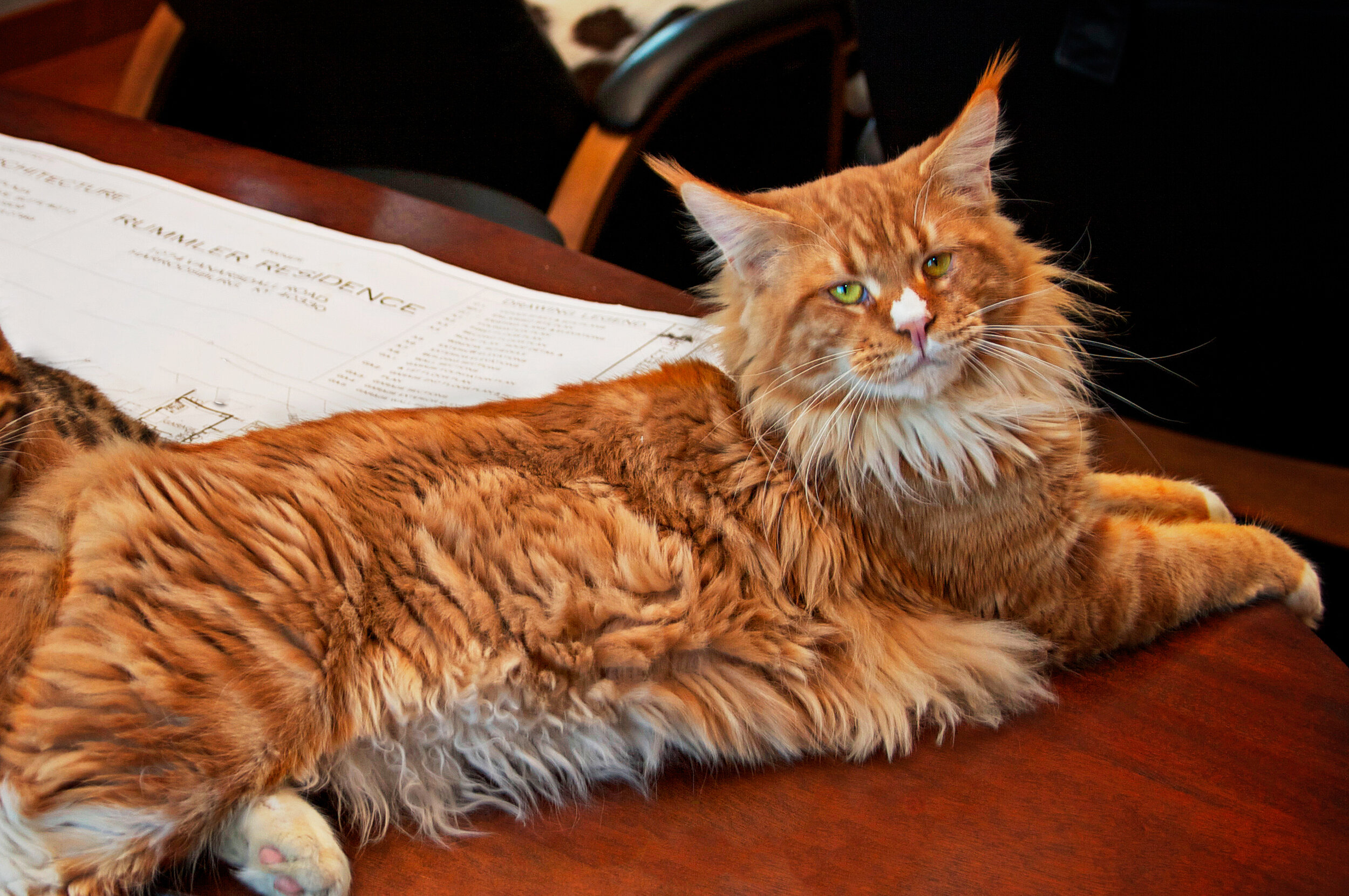
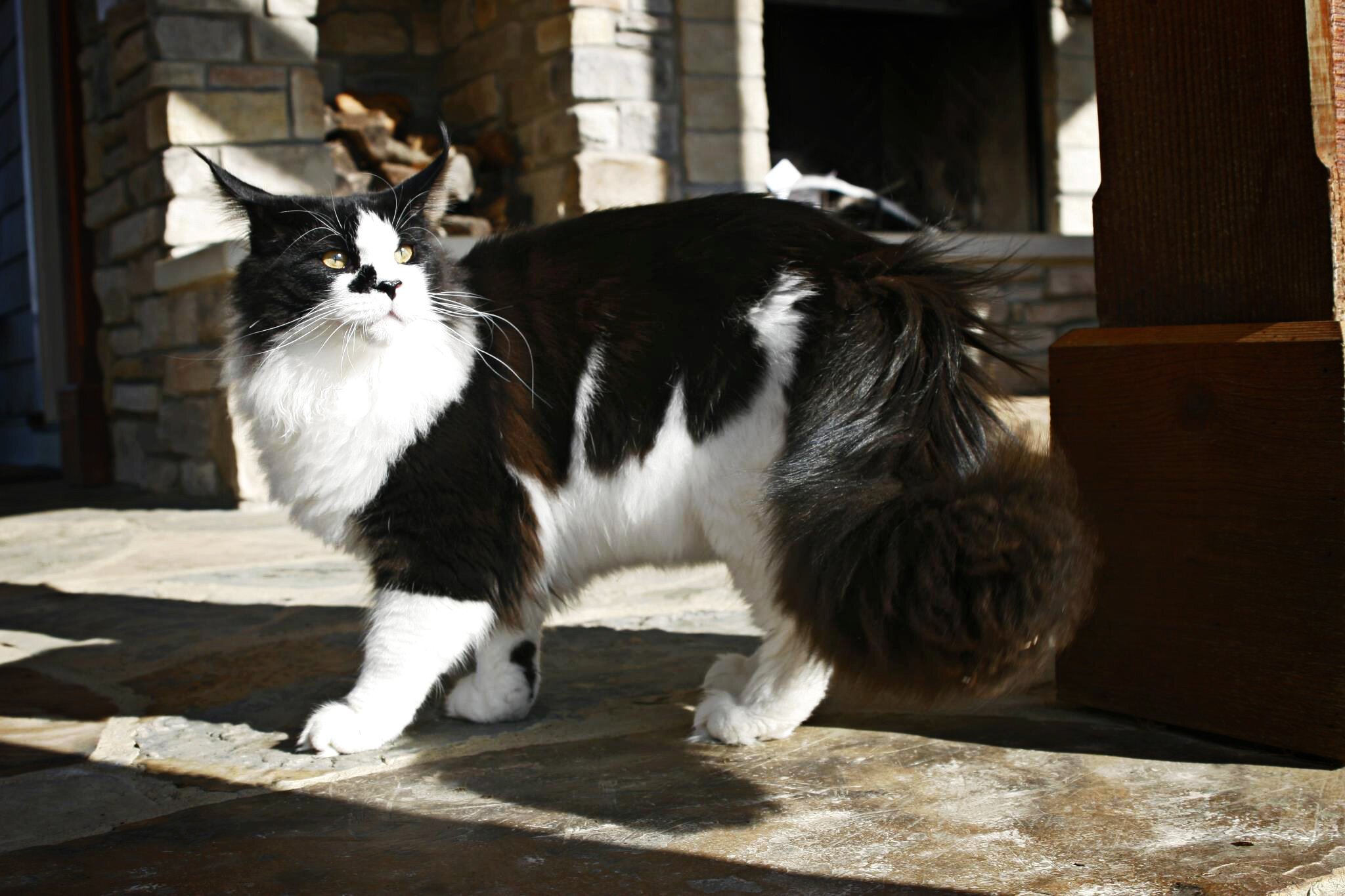
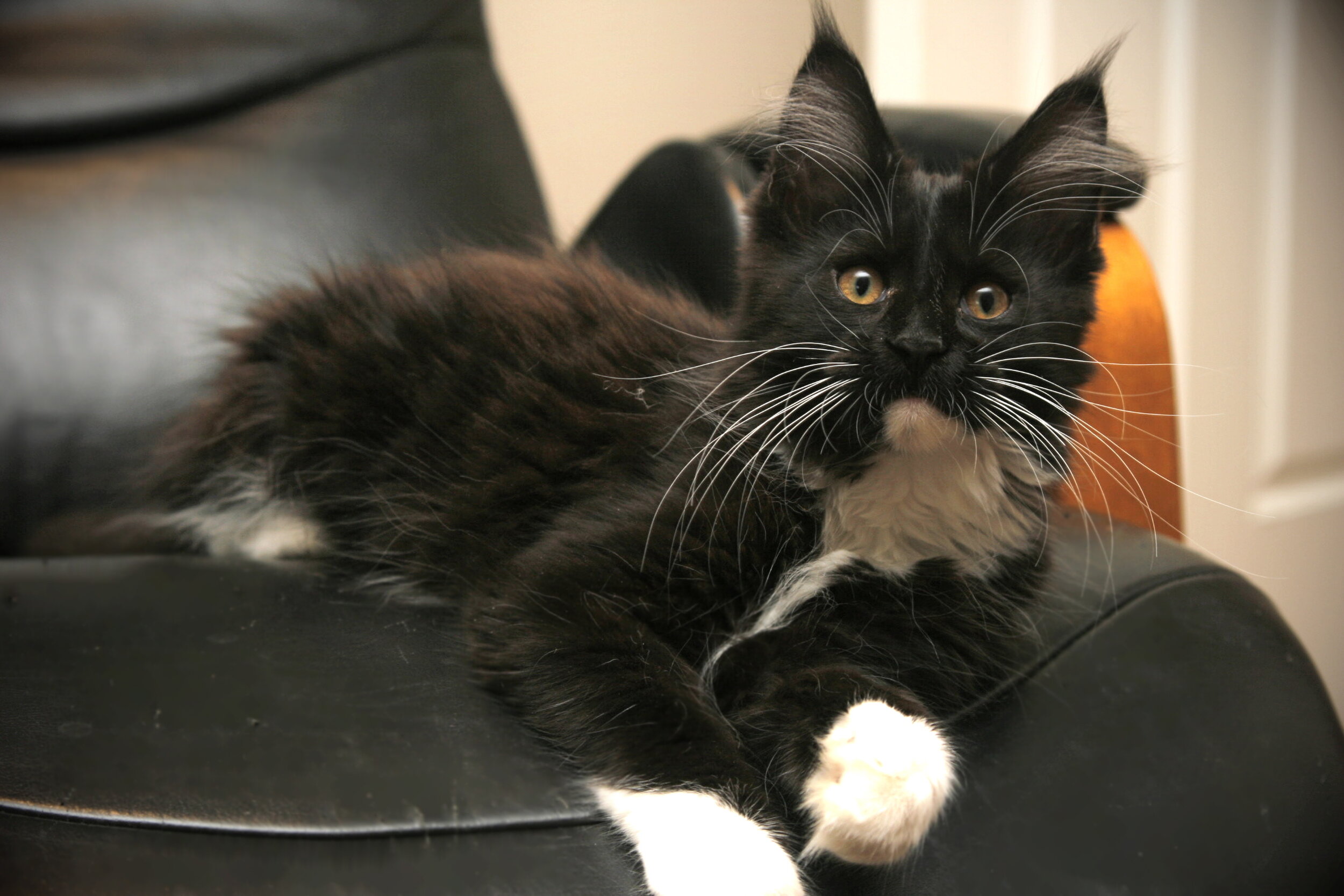

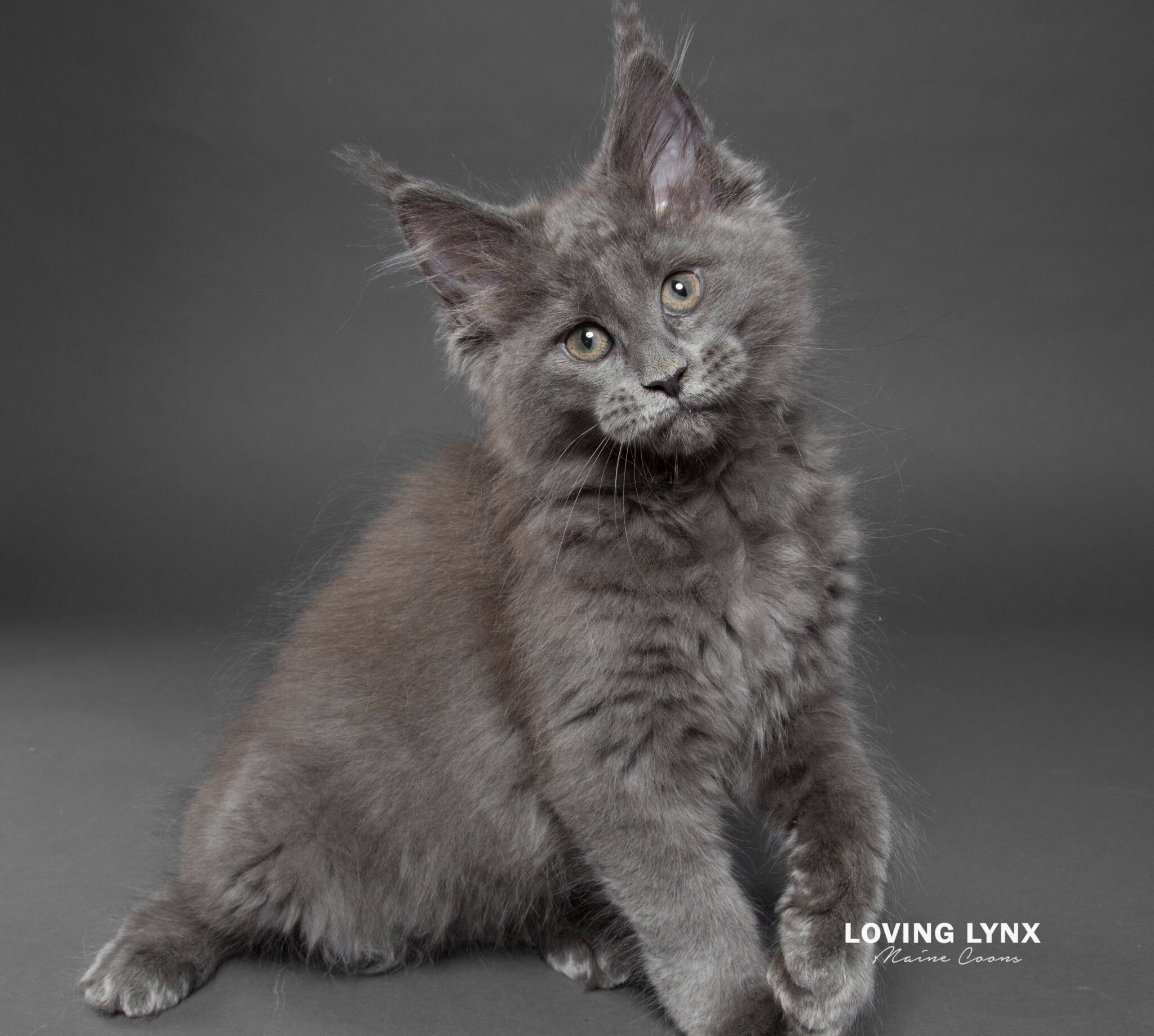
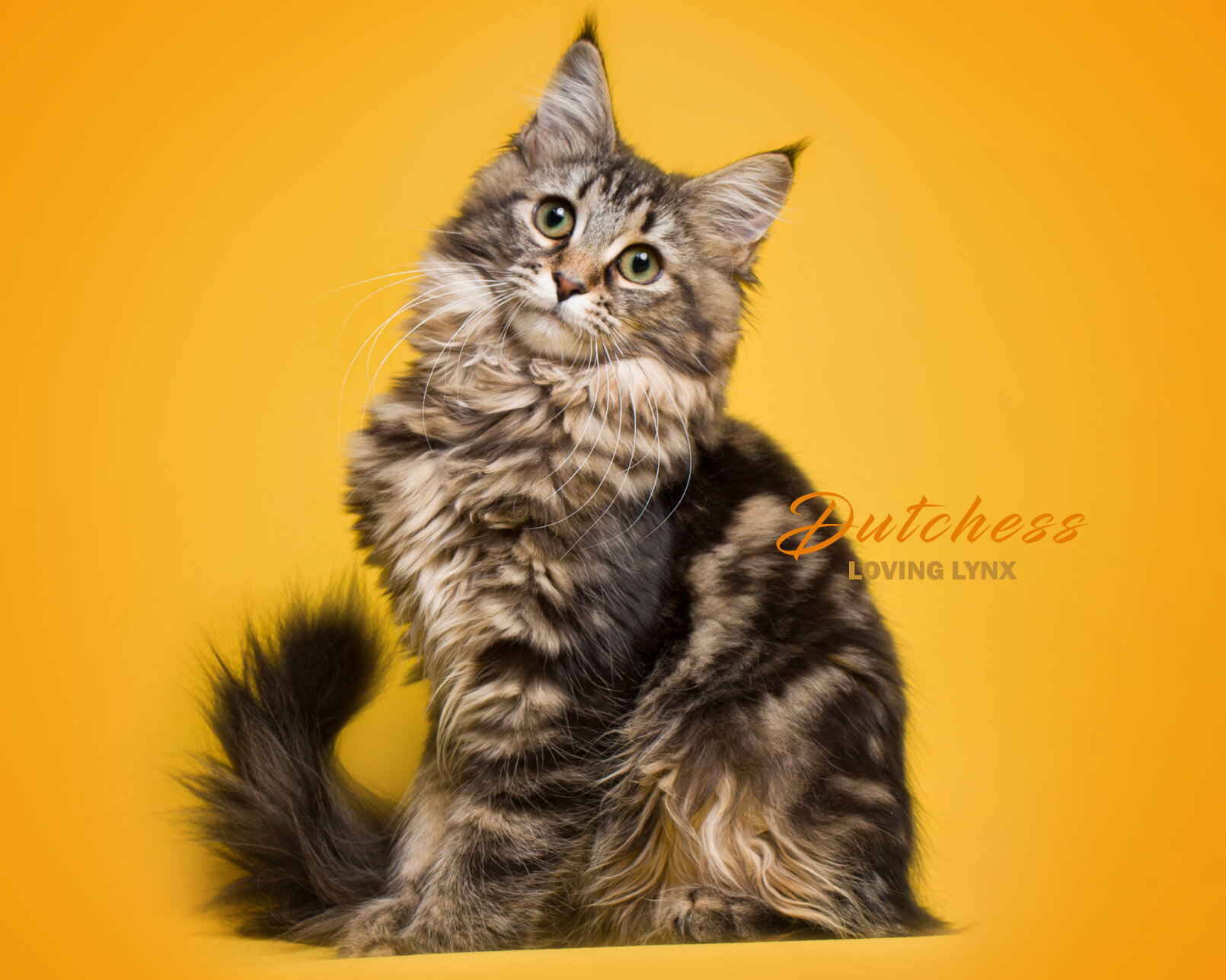
White is counted as an absence of color rather than a color!
Colors as listed on CFA (Cat Fanciers’ Association) website 2018
www.CFA.org
Maine Coon Breed Standard
Maine Coons can are registered with CFA, ACFA, FIFe, and TICA. Initially bred for hunting skills, today they are slow-paced hunters more likely to cuddle your mouse than hunt it!The Maine Coon has a notable gentle disposition, loves to cuddle, loves everyone, has low energy needs, and can adapt to any home.
What is a breed standard?
Breed standards are devised by breed associations or breed clubs, not by individuals, and are written to reflect the use or purpose of the species and breed of the animal. Breed standards help define the ideal animal of a breed and provide goals for breeders in improving stock. Breeders often say the standard is the guide to pursue excellence.
Each breed standard represents in words the ideal picture for which breeders strive. Breed standards reflect our ideal specimen which show cats will be evaluated. In each standard, you will even see an entire section on the breed’s ideal temperament.
What is a “breed club”?
There is a parent club or breed club that creates dog breeding standards in the first place. This parent club may choose to create an entirely new standard, update an existing one, or let the standard remain as it is.
ACF standard
ACFA/CAA standard
CCA-AFC standard
GCCF standard
Maine Coon Compared To Other Breeds
From Guide to House Cats - Source: http://majnouna.deviantart.com/
Maine Coon Health Concerns
Maine Coons are at risk for genetic conditions such as HCM, PKD, SMA. DNA tests now exist to prevent feline diseases to be exact. These DNA test are now much more affordable than ever. Maine Coons are still at risk for non-genetic cat health concerns, the same as all other cat breeds.
Non-Genetic Health Conditions
Non-genetic health conditions are caused by environmental factors, such as diet, stress, or exposure to toxins.
Genetic Health Conditions
Genetic health conditions are caused by abnormalities in a person's DNA.(faulty genes) These conditions can affect many parts of the body, including the heart, lungs, brain, and muscles.
Multifactorial Health Conditions
Multifactorial conditions are health problems that are caused by a combination of genetic and environmental factors. They are also known as complex diseases.
Regardless of breed cat owners should obtain health insurance to prevent foreseen or unforeseen medical cost!
Non-Genetic Health Concerns
Cancer
Cancer is a class of diseases in which cells grow uncontrollably, invade surrounding tissue and may spread to other areas of the body. As with people, cats can get various kinds of cancer. The disease can be localized (confined to one area, like a tumor) or generalized (spread throughout the body).
Diabetes
Diabetes in cats is a complex disease caused by either a lack of the hormone insulin or an inadequate response to insulin. After a cat eats, her digestive system breaks food into various components, including glucose—which is carried into her cells by insulin. When a cat does not produce insulin or cannot utilize it normally, her blood sugar levels elevate. The result is hyperglycemia, which, if left untreated, can cause many complicated health problems for a cat.
Feline Immunodeficiency Virus (FIV)
Cats infected with feline immunodeficiency virus (FIV) may not show symptoms until years after the initial infection occurred. Although the virus is slow-acting, a cat’s immune system is severely weakened once the disease takes hold. This makes the cat susceptible to various secondary infections. Infected cats receiving supportive medical care and kept in a stress-free, indoor environment can live relatively comfortable lives for months to years before the disease reaches its chronic stages.
Feline Leukemia Virus (FelV)
First discovered in the 1960s, feline leukemia virus is a transmittable RNA retrovirus that can severely inhibit a cat’s immune system. It is one of the most commonly diagnosed causes of disease and death in domestic cats. Because the virus doesn’t always manifest symptoms right away, any new cat entering a household—and any sick cat—should be tested for FeLV.
Heartworm
Spread by infected mosquitoes, heartworm is increasingly being recognized as an underlying cause of health problems in domestic cats. Cats are an atypical host for heartworms. Despite its name, heartworm primarily causes lung disease in cats. It is an important concern for any cat owner living in areas densely populated by mosquitoes, and prevention should be discussed with a veterinarian.
Hairballs
Rabies
Rabies is a viral disease that affects the brain and spinal cord of all mammals, including cats, dogs and humans. This preventable disease has been reported in every state except Hawaii. There’s good reason that the very word “rabies” evokes fear in people—once symptoms appear, rabies is close to 100% fatal.
Ringworm
Although the name suggests otherwise, ringworm isn’t caused by a worm at all—but a fungus that can infect the skin, hair and nails. Not uncommon in cats, this highly contagious disease can lead to patchy, circular areas of hair loss with central red rings. Also known as dermatophytosis, ringworm often spreads to other pets in the household—and to humans, too.
Upper Respiratory Infections
A cat’s upper respiratory tract—the nose, throat and sinus area—is susceptible to infections caused by a variety of viruses and bacteria.
Worms
Cats can acquire a variety of intestinal parasites, including some that are commonly referred to as “worms.” Infestations of intestinal worms can cause a variety of symptoms. Sometimes cats demonstrate few to no outward signs of infection, and the infestation can go undetected despite being a potentially serious health problem. Some feline parasitic worms are hazards for human health as well.
Digestive Blockages
Genetic Concerns
Acute Intermittent Porphyria (Variant 1)
Acute intermittent porphyria (AIP) is a disorder caused by decreased cellular enzymatic activity leading to an accumulation of byproducts, called porphyrins, in the tissues. The disease is characterized by the brownish coloration of the teeth and brownish urine of affected cats.
Acute Intermittent Porphyria (Variant 2)
Acute intermittent porphyria (AIP) is a disorder caused by decreased cellular enzymatic activity leading to an accumulation of byproducts, called porphyrins, in the tissues. The disease is characterized by the brownish coloration of the teeth and brownish urine of affected cats.
Acute Intermittent Porphyria (Variant 3)
Acute intermittent porphyria (AIP) is a disorder caused by decreased cellular enzymatic activity leading to an accumulation of byproducts, called porphyrins, in the tissues. The disease is characterized by the brownish coloration of the teeth and brownish urine of affected cats.
Acute Intermittent Porphyria (Variant 4)
Acute intermittent porphyria (AIP) is a disorder caused by decreased cellular enzymatic activity leading to an accumulation of byproducts, called porphyrins, in the tissues. The disease is characterized by the brownish coloration of the teeth and brownish urine of affected cats.
Acute Intermittent Porphyria (Variant 5)
Acute intermittent porphyria (AIP) is a disorder caused by decreased cellular enzymatic activity leading to an accumulation of byproducts, called porphyrins, in the tissues. The disease is characterized by the brownish coloration of the teeth and brownish urine of affected cats.
Autoimmune Lymphoproliferative Syndrome
Autoimmune Lymphoproliferative Syndrome is an immunologic disorder characterized by severely enlarged lymph nodes.
Burmese Head Defect (Discovered in the Burmese)
Burmese Head Defect is a disorder where cats with two copies of the mutation will be born with severe facial defects requiring humane euthanasia shortly after birth.
Chediak-Higashi Syndrome (Discovered in the Persian)
Chediak-Higashi Syndrome (CHS) is a metabolic disoder that causes partial albinism, sensitivity to light, cataracts at an early age, and prolonged bleeding.
Congenital Adrenal Hyperplasia
Congenital adrenal hyperplasia is an endocrine disorder that causes excessive drinking and urination, abnormalities of the genitallia, and aggression.
Congenital Erythropoietic Porphyria
Congenital Erythropoietic Porphyria (CEP) is a disorder caused by decreased cellular enzymatic activity leading to an accumulation of byproducts, called porphyrins, in the tissues. The disease is characterized by the brownish coloration of the teeth and brownish urine of affected cats.
Congenital Myasthenic Syndrome (Discovered in the Devon Rex and Sphynx)
Congenital Myasthenic Syndrome (CMS) is a neuromuscular disorder characterized by muscle weakness and fatigue.
Cystinuria Type 1A
Cystinuria is a metabolic disorder which predisposes the affected cat to form cystine crystals and stones within the urinary tract, which can then cause irritation and blockage.
Cystinuria Type B (Variant 1)
Cystinuria is a metabolic disorder which predisposes the affected cat to form cystine crystals and stones within the urinary tract, which can then cause irritation and blockage.
Cystinuria Type B (Variant 2)
Cystinuria is a metabolic disorder which predisposes the affected cat to form cystine crystals and stones within the urinary tract, which can then cause irritation and blockage.
Cystinuria Type B (Variant 3)
Cystinuria is a metabolic disorder which predisposes the affected cat to form cystine crystals and stones within the urinary tract, which can then cause irritation and blockage.
Dihydropyrimidinase Deficiency
Dihydropyrimidinase deficiency is a metabolic disorder that causes tiredness, weakness, vomiting, and high levels of ammonia in the blood.
Earfold and Osteochondrodysplasia (Discovered in the Scottish Fold)
Earfold and osteochondrodysplasia (discovered in the Scottish Fold) is the condition behind the breed defining folded ears; however, it also associated with skeletal malformations and arthritis.
Factor XII Deficiency (Variant 1)
Factor XII deficiency is a common blood factor deficiency in cats which does not result in an abnormal tendency to bleed but may have an effect on blood clot stability.
Factor XII Deficiency (Variant 2)
Factor XII deficiency is a common blood factor deficiency in cats which does not result in an abnormal tendency to bleed but may have an effect on blood clot stability.
Familial Episodic Hypokalemic Polymyopathy (Discovered in the Burmese)
Familial Episodic Hypokalaemic Polymyopathy is a disorder that causes skeletal muscle weakness and pain that is episodic in nature.
GM1 Gangliosidosis
GM1 Gangliosidosis is a disorder characterized by progressive nervous system degeneration with signs including incoordination of movements and tremors.
GM2 Gangliosidosis
GM2 Gangliosidosis is a disorder characterized by progressive nervous system degeneration with signs including incoordination of movements and tremors.
GM2 Gangliosidosis Type II (Discovered in Domestic Shorthair cats)
GM2 Gangliosidosis Type II is a disorder characterized by progressive nervous system degeneration with signs including incoordination of movements and tremors.
GM2 Gangliosidosis Type II (Discovered in Japanese domestic cats)
GM2 Gangliosidosis Type II is a disorder characterized by progressive nervous system degeneration with signs including incoordination of movements and tremors.
GM2 Gangliosidosis Type II (Discovered in the Burmese)
GM2 Gangliosidosis Type II is a disorder characterized by progressive nervous system degeneration with signs including incoordination of movements and tremors.
Glutaric Aciduria Type II
Glutaric Aciduria Type II is a rare metabolic disorder that causes organic acids to accumulate in the blood and urine.
Glycogen Storage Disease (Discovered in the Norwegian Forest Cat)
Glycogen Storage Disease Type IV is a disorder that affects the metabolism of glycogen resulting in low blood sugar levels and progressive neuromuscular disease.
Hemophilia B (Variant 1)
Hemophilia B, also known as Factor IX Deficiency, is a blood clotting disorder more commonly seen in males, which can result in tiredness, decreased appetite, fever, lameness, and prolonged bleeding times after injury, trauma or surgery.
Hemophilia B (Variant 2)
Hemophilia B, also known as Factor IX Deficiency, is a blood clotting disorder more commonly seen in males, which can result in tiredness, decreased appetite, fever, lameness, and prolonged bleeding times after injury, trauma or surgery.
Hyperoxaluria Type II
Hyperoxaluria is a kidney disorder leading to profound weakness and acute kidney disease at a young age.
Hypertrophic Cardiomyopathy (Maine Coon Type)
Hypertrophic cardiomyopathy is a disorder where the heart muscle wall increases in thickness, eventually leading to heart failure.
Hypertrophic Cardiomyopathy (Ragdoll Type)
Hypertrophic cardiomyopathy is a disorder where the heart muscle wall increases in thickness, eventually leading to heart failure.
Hypotrichosis (Birman Type)
Hypotrichosis is a disorder of the immune system causing kittens to be born hairless and to develop serious infections.
Lipoprotein Lipase Deficiency
Lipoprotein Lipase Deficiency is a metabolic disorder that causes reduced body mass and growth rates in kittens, lipemia (excessive fatty substances in the blood), and increased stillbirth rates.
MDR1 Medication Sensitivity
Medication Sensitivity (or Multidrug Resistance 1) is a disorder resulting from a defective drug pumping protein that plays an important role in limiting drug absorption and distribution (particularly to the brain). Cats with the ABCB1 mutation may have severe adverse reactions to some commonly used medications.
Mucopolysaccharidosis Type I
Mucopolysaccharidosis Type I is a disorder causing failure to thrive, facial and other skeletal abnormalities, tremors, and corneal clouding.
Mucopolysaccharidosis Type VI (Variant 1)
Mucopolysaccharidosis VI is a lysosomal storage disease resulting in a degenerative joint disease. This mutation (the G1558A variant) may cause for a mild form of the disease, but only if one copy of the severe disease variant (the T1427C variant) is also present.
Mucopolysaccharidosis Type VI (Variant 2)
Mucopolysaccharidosis Type VI is a disorder causing dwarfism, degenerative joint disease, and corneal clouding.
Mucopolysaccharidosis Type VII (Variant 1)
Mucopolysaccharidosis Type VII is a disorder causing weakness, growth retardation, facial and other skeletal abnormalities, and corneal clouding.
Mucopolysaccharidosis Type VII (Variant 2)
Mucopolysaccharidosis Type VII is a disorder causing weakness, growth retardation, facial and other skeletal abnormalities, and corneal clouding.
Myotonia Congenita
Myotonia Congenita is a neuromuscular disorder that affects cats from birth, causing stiff movement and delayed relaxation of muscles after exercise.
Polycystic Kidney Disease (PKD)
Polycystic kidney disease is the most common inherited disease in cats. The disease causes the formation of fluid-filled cysts in the kidneys that can lead to kidney failure.
Progressive Retinal Atrophy (Discovered in the Abyssinian)
Progressive Retinal Atrophy (PRA) is a disorder that causes the degeneration of the light sensing retina at the back of the eye, resulting in vision loss.
Progressive Retinal Atrophy (PRA)
Progressive Retinal Atrophy (PRA) is an eye disorder that causes the degeneration of the light sensing retina at the back of the eye, resulting in vision loss.
Pyruvate Kinase Deficiency
Pyruvate Kinase (PK) Deficiency is a disorder that causes anemia due to the breakdown of red blood cells.
Sphingomyelinosis (Variant 1)
Sphingomyelinosis (Mutation 1) is a neurological disorder that causes progressively severe neurologic signs, enlargement of the spleen and liver, and changes in the lungs.
Sphingomyelinosis (Variant 2)
Sphingomyelinosis (Mutation 2) is a neurological disorder that causes progressively severe neurologic signs and reduced menace response.
Spinal Muscular Atrophy (SMA)
Spinal muscular atrophy is a muscular disorder that causes muscle wasting and progressive weakness. Please note that this test detects presence or absence of the disease mutation and cannot distinguish cats that have one copy of the disease mutation from cats with two copies of the disease mutation.
Vitamin D-Dependent Rickets
Vitamin D-Dependent Rickets (VDDR) is a metabolic disorder resulting in low blood calcium levels and skeletal abnormalities.
Multifactorial Conditions
Hip Dysplasia
Hip dysplasia is a multifactorial condition that's caused by a combination of genetic and environmental factors. Environmental factors alone can't cause hip dysplasia, but they can influence whether a person or animal with the genetic predisposition will develop it. Cats with hip dysplasia can still lead long and fulfilling lives with appropriate care and management however surgery is a permanent fix that will last lifelong. Diet, body condition, and cultural habits can increase the risk of hip dysplasia.
Heart Murmur
Many heart murmurs are considered "innocent" and are not caused by genetic factors, often appearing in children due to normal developmental variations in the heart valves. While a heart murmur itself isn't directly "genetic," certain conditions that cause heart murmurs can be inherited, meaning a family history of heart murmurs or specific heart valve problems can increase your risk of developing one due to genetic factors; therefore, a heart murmur can be considered "genetic" in some cases depending on the underlying cause. Multifactorial conditions can increase the risk of heart murmurs, which are sounds caused by turbulent blood flow through the heart.
Progressive Retinal Atrophy - PRA
Progressive Retinal Atrophy (PRA-CRX) or PRA is a group of degenerative diseases that affect these photoreceptor cells. With this disease, the cells deteriorate over time, eventually leading to blindness in the affected cat.
What is Progressive Retinal Atrophy (PRA)?
Progressive Retinal Atrophy (PRA-CRX) or PRA is a group of degenerative diseases that affect these photoreceptor cells. With this disease, the cells deteriorate over time, eventually leading to blindness in the affected cat.
How is PRA inherited?
This is an autosomal recessive condition, meaning two copies of the mutation are required for the cats to lose their vision. Dam and sire must both be carreirs to produce affected offspring. Carriers have one copy of the mutation. Carriers are not affected and have normal vision.
PRA Symptoms
Dilated pupils
Inability to see clearly in bright light
In some conditions, only central vision may be lost and the cat may still retain peripheral vision
The pupil (opening of the eye) has abnormal reactions to light
The retinal structure appears abnormal when a doctor examines it with an ophthalmoscope; cataract may be observed
The liver may also be affected, obesity may be observed
What is the retina?
The retina is the tissue that lines the inner surface of the eye, and is the light sensitive part of the eye that acts as the brain's camera, transmitting images through the rods and cones that are part of its structure, thus enabling the experience of vision. The retina is part of the central nervous system (CNS) and the only part of the CNS that can be easily imaged and examined. In retinal degeneration, the cells of the retina begin to decline in function, thereby leading to impaired vision or even blindness. There are many causes for retinal degeneration.
PRA Genetic Testing
A single nucleotide mutation in the gene called CEP290 produces a defective protein which is associated with this progressive retinal atrophy (PRA) in the cat. In addition to Abyssinian, Somali and Ocicat, a survey of 43 cat breeds showed presence of the CEP290 mutation in many other breeds including, American Curl, American Wirehair, Bengal, Balinese/Javanese, Colorpoint Shorthair, Cornish Rex, Munchkin, Oriental Shorthair, Peterbald, Siamese, Singapura and Tonkinese. The high frequency of the CEP290 mutation in Siamese (about 33%) and related breeds (Oriental Shorthair, Balinese/Javanese, Colorpoint Shorthair, Peterbald) poses a significant health risk in the Siamese breed group.
| Test Result | CEP290 PRA-rdAc Status |
|---|---|
| N/N | Normal, cat does not have rdAc mutation* |
| N/rdAc | Carrier, cat has one copy of rdAc mutation. Breedings between carriers will be expected to produce 25% affected kittens. |
| rdAc/rdAc | Affected |
Polycystic Kidney Disease - PKD
Polycystic kidney disease or PKD is an inherited condition in cats that causes multiple cysts (pockets of fluid) to form in the kidneys. These cysts are present from birth. Initially, they are very small but they grow larger over time and may eventually disrupt kidney function resulting in kidney failure.
Polycystic kidney disease or PKD is an inherited condition in cats that causes multiple cysts (pockets of fluid) to form in the kidneys. These cysts are present from birth. Initially, they are very small but they grow larger over time and may eventually disrupt kidney function resulting in kidney failure.
Unfortunately, PKD1 does not have a strong clinical presentation. The presentation of PKD1 is similar to one of the most common causes of death for any cat, renal failure. Thus, PKD1 has gone unnoticed for many years and has spread throughout the Persian breed. Any breed that has used Persians in their foundation or propagation should have concerns for PKD1.
How is polycystic kidney disease inherited?
Polycystic kidney disease (PKD) has been shown to be inherited as a single autosomal dominant gene, meaning one copy of the mutation is required. Only one parent must be a carrier to produce affected offspring.
How prevalent is PKD?
It is estimated over 37% of Persians have polycystic kidney disease (PKD), a breed that accounts for nearly 80% of the cat fancy. Many lines and catteries have been able to greatly reduce this frequency by using ultrasound screening methods and improved breeding practices.
PKD Treatment
There is no specific treatment for polycystic kidney disease (PKD), as the disease causes similar clinical signs to those seen in cats with chronic kidney disease. Special diets, fluid therapy, and medications to reduce nausea and vomiting and to block the absorption of phosphorus are often used to treat the symptoms of kidney failure.
Resources
https://www.vgl.ucdavis.edu/services/pkd1.php
https://vcahospitals.com/know-your-pet/kidney-disease-polycystic-kidney-disease-in-cats
Hypertrophic Cardiomyopathy - HCM
Feline Hypertrophic Cardiomyopathy or HCM is a condition that causes the muscular walls of a cat’s heart to thicken, decreasing the heart’s efficiency and sometimes creating symptoms in other parts of the body. Although the cause of HCM has not been clearly identified, the fact that the condition is more prevalent in certain breeds (including Maine Coon, Ragdoll, British Shorthair, Sphynx, Chartreux and Persian cats) and that mutations of several cardiac (heart) genes have been identified in some cats with this disease suggests that genetics plays a role.
Feline Hypertrophic Cardiomyopathy or HCM is a condition that causes the muscular walls of a cat’s heart to thicken, decreasing the heart’s efficiency and sometimes creating symptoms in other parts of the body. Although the cause of HCM has not been clearly identified, the fact that the condition is more prevalent in certain breeds (including Maine Coon, Ragdoll, British Shorthair, Sphynx, Chartreux and Persian cats) and that mutations of several cardiac (heart) genes have been identified in some cats with this disease suggests that genetics plays a role. Hypertrophic cardiomyopathy is the most prevalent heart disorder in cats and the principal cause of cardiovascular morbidity and mortality.
How is HCM inherited?
This is an autosomal recessive condition, meaning two copies of the mutation are required for the cats to lose their vision. Dam and sire must both be carriers to produce affected offspring. Carriers have one copy of the mutation. Carriers are not affected.
HCM Symptoms
Many cats with HCM do not appear to be ill. Others may show signs of congestive heart failure, including labored or rapid breathing, open-mouthed breathing, and lethargy. These symptoms occur when fluid accumulates in or around the lungs.
Loss of appetite (anorexia)
Lethargy.
Weak pulse.
Difficulty breathing.
Short, rough, snapping breathing sounds (crackles)
Abnormal heart sounds (i.e., muffled, galloping rhythm, murmurs)
Inability to tolerate exercise or exertion.
How prevalent is HCM?
About 30% of Maine coon cats have a genetic mutation.
Genetic Testing
The A31P breed-specific mutation for inherited HCM in Maine Coon cats produces moderate to severe cardiac disease which can lead to sudden death by age 4 years or less for cats that carry two copies of the mutation (homozygotes). Cats that carry one copy of the mutation (heterozygotes) have a longer life expectancy, but may still develop HCM. The mutation is a single base pair change in MYBPC3 that disrupts the production of the cardiac myosin binding protein C needed for normal heart muscle development. The Veterinary Genetics Laboratory offers a test for the Maine Coon breed-specific HCM mutation (University of California, Davis).
| Test Result | Maine Coon HCM Status |
|---|---|
| N/N | Normal |
| N/HCMmc | One copy of the A31P mutation is present. Cat is 1.8 times more likely to develop HCM than cats without the mutation. |
| HCMmc/HCMmc | Two copies of the A31P mutation are present. Cat is 18 times more likely to develop HCM than cats without the mutation. |
Treatment
Medications to slow the heart rate, correct abnormal heartbeats, and improve blood flow and cardiac function
Medications to decrease blood clot formation
Medication to alleviate fluid build-up with congestive heart failure
Diet aimed at minimizing sodium intake and optimizing adequate nutrition for congestive heart failure
Resources
https://academic.oup.com/eurheartj/article-abstract/40/12/982/5053980?redirectedFrom=fulltext
https://www.vgl.ucdavis.edu/services/cat/MaineCoonHCM.php
https://www.ufaw.org.uk/cats/maine-coon-hypertrophic-cardiomyopathy
Inhibitor Gene: Smoke, Shaded, Shell
Explaining the difference between Smoke, Shaded, and Shell is a tad bit complicated. But once you know the basics it really not as confusing as you might think. If you would like the most simplified explanation these three types are all caused by the “inhibitor gene” sometimes called the “silver gene”. Each varies in the amount of color left to the coat.
Maine Coon Color Diagram: Smoke, Shaded, Shell
Explaining the difference between Smoke, Shaded, and Shell is a tad bit complicated. But once you know the basics it really not as confusing as you might think. If you would like the most simplified explanation these three types are all caused by the “inhibitor gene” sometimes called the “silver gene”. Each varies in the amount of color left to the coat.
What color is your cat?
1/8 of hair length colored at tip – shell
1/4 of hair length colored at tip – all shaded
1/2 of hair length colored at tip – all smoke
Tarnishing
When the Inhibitor gene fails to completely block pigment (it is more effective at blocking black-based pigment than blocking red-based pigment) and there is a breakthrough of reddish color known as "tarnishing". Tarnishing is common on the muzzles of random-bred silver tabbies, but rare on pedigree silver tabbies due to selective breeding and refinement.
“Wide Band” Effect
For convenience, breeders talk of Wide Band as a single gene, but there appear to be multiple interacting genes that determine the width of the pale band between the pigmented tip and the follicle. The presence or absence of the Inhibitor (silver) gene does not affect the Wide Band effect. Golden Shaded lacks the Inhibitor gene but has a shading pattern comparable to Silver Shaded cats.
Non-agouti + Wide Band = Solid Color
Non-agouti + Wide Band + inhibitor gene= Smoke Pattern
Agouti + Wide Band = Golden series
Agouti + Wide Band + inhibitor gene = Silver series
The extreme wide-banding effect is very rare and at first, the look will appear to be “Shaded” instead of “Smoke” due to the high level of white. A solid color nose is indicative of non-agouti (Smoke), this can be confirmed by DNA testing.
Melanin inhibitor gene is a dominant gene. This means a non-expressing cat can not carry this gene . Offspring can receive this gene from either parent but only if one or both parent has the gene. The Inhibitor gene has a greater affect on the yellow pigment phaeomelanin than on black pigment eumelanin.
Silver Maine Coon
Silver Maine Coons have dark “eyeliner”, that is the black outline that surrounds the eyes, and sometimes the nose. A silver kitten’s nose will always be a rosy pink or wine color.
White Maine Coons will have soft pink noses and no eyeliner. White kittens paw pads will also be light pink in color.
Blue Maine Coons their shimmering coat appears almost silver and they're considered to be a long-haired variety of the Russian Blue.
Smoke Maine Coon
Smoke Maine Coons are a solid color cat that carries the inhibitor gene which suppresses the color in the hair shaft. This means that the cat's hairs are dark (usually black) at the tips but have much lighter colored bands near the bottom. All solid colors can be affected by the inhibitor gene which labels them “Smoke” plus the underlining solid color. A young non-smoke cat has a kitten coat that is often a lot lighter than the base color of the cat. The cat can look like a smoke, but because neither parent cat has a white undercoat, the kitten cannot be a smoke. The kitten coat will darken as the cat gets older.
Smoke Maine Coon Cats have more than 33% of the hair ends colored.
Solid Blue + Inhibitor Gene = Blue Smoke Maine Coon
Solid Red + Inhibitor Gene = Red Smoke Maine Coon
Shaded Maine Coon
Shaded Color Maine Coon Cats have 33% or 1/3 of the hair ends are colored. This is the second to lightest degree of “tipping” within the Maine Coon Breed. In other breeds such cats maybe refereed to as “Shaded” or “Chinchilla” Lesser degree of wide-band than a “shell” and more than a smoke.
Inhibitor + Wide-Band = Shaded
Shell Maine Coon
Shell Maine Coon Cats have 12% or 1/8 of the hair ends are colored.
| Smoke Maine Coon | aa I- | - | For "I-" you can either have II (homozygous for silver) or Ii (heterozygous for silver) |
| Shaded Maine Coon | A- I- |
plus genes for tabby | For "A-" you can either have AA or Aa. For "I-" you can have II or Ii. Note that silver tabby, shaded and shell have the same genetic code for their coat colour. |
| Shell Maine Coon | A- I- |
||
| Silver Maine Coon | A- I- Ta- ticked |
For "Ta-" you can have TaTa, or
Tata. You find TaTa f.e. in the Somali or Abyssinian. |
|
| A- I- Mc- mackerel |
For "Mc-" you can have McMc or
Mcmc. Note: You may add Ta- or tata to this code. |
||
| A- I- mcmc blotched |
Resources
http://www.mat.uniroma2.it/~picard/Cats/Feline_genetics_notes.pdf (Old Theory)
http://www.mainecooneducation.com/
Spinal Muscular Atrophy - SMA
Spinal muscular atrophy is an inherited neurodegenerative disorder that has been identified in Maine coon cats, and is similar to human spinal muscular atrophy. How is Spinal muscular atrophy inherited? This is an autosomal recessive condition, meaning two copies of the mutation are required for the cats to lose their vision. Dam and sire must both be carriers to produce affected offspring. Carriers have one copy of the mutation. Carriers are not affected.
Spinal muscular atrophy is an inherited neurodegenerative disorder that has been identified in Maine coon cats, and is similar to human spinal muscular atrophy. How is Spinal muscular atrophy inherited? This is an autosomal recessive condition, meaning two copies of the mutation are required for the cats to lose their vision. Dam and sire must both be carriers to produce affected offspring. Carriers have one copy of the mutation. Carriers are not affected.
SMA Symptoms
Fine muscle tremors and fascilculations
Progressive muscular weakness and instability
Abnormal posture
SMA Genetic Testing
SMA in Maine Coon cats is caused by a large deletion of chromosome 1.
| Test Result | Spinal Muscular Atrophy Status |
|---|---|
| N/N | No copies of SMA are present. |
| N/S | 1 copy of SMA is present. Cat is normal but is a carrier. Breeding between carriers will be expected to produce 25% affected, 50% carriers and 25% normal kittens. |
| S/S | 2 copies of SMA are present, cat is affected. |
Maine Coon Toys
The Maine Coon is an extra-large cat because of this they can require different types of toys and cat trees than your average cat.
New Cat Condos
These are my highest recommendation. These are the cat’s favorites and they are good quality with no building required. Can be purchased through Walmart.com
Cat Tree King
Refined Feline
Vesper
Hollywood Kitty Co
K9 Kennel Store
Offering a variety of wall shelves and cat enclosures.
European vs. American - The Evolution of Maine Coons
The Maine Coon community is buzzing like never before, thanks to the influence of social media. With breeders and enthusiasts connecting worldwide, it's become evident that two unique styles of Maine Coons have developed: the American and the European. The future of the extreme European Type Maine Coons is likely to lead to either a revision of the breed standard or the emergence of a separate breed altogether. However, the most likely outcome is a gradual blending of the different styles, with specific bloodlines showcasing the more "extreme" features of each type.
Breeders are frequently confronted with inquiries regarding the reasons behind the extreme variations in appearance among certain bloodlines. The Maine Coon breed has been shaped globally by various governing registries, where the members, who are breeders, participate in voting on the breed standard. Consequently, numerous registries worldwide maintain distinct but similar breed standards for the Maine Coon.
The breed is commonly categorized into two distinct "types" recognized by the public: American and European. European Maine Coons are characterized by more pronounced facial features in comparison to their American counterparts, exhibiting a more defined muzzle, fuller ear tufts, and an overall "feral" look. Despite these differences, both types typically share the same body structure and possess a long, thick coat. The European style is frequently regarded as having a more impressive and authoritative presence than the American variety, with breeders often emphasizing exaggerated traits.
Registry Timeline
1869 - Maine coons were first presented at a cats show in the United States. The breed was formed in northeastern states of the USA, especially the state of Maine from which it gets it name.
1906 - The Cat Fanciers' Association (CFA) was founded which recognized Maine Coons
1950s - Breed was claimed to be going extinct due to lack of entries.
1980s - Maine Coon Cats were first exported to the United Kingdom
1982 - Maine Coon Breed were first recognised by Fédération Internationale Féline (FIFe)
1993 - Maine Coon was first recognized by the Governing Council of the Cat Fancy (GCCF)
American Type
American Maine Coon breeders typically follow standards set by the organization Cat Fancier Association (CFA), while The International Cat Association (TICA) is the second major largest registry used in America. The CFA “American Standard” (CFA and TICA) specifies no extreme features, the maine coon should be balanced in all traits. "proportioned and balanced with no exaggerations”.
Click Here - CFA Maine Coon Standard
Key Points About American Type
Size: Same
Temperament: Same
Eyes: European Maine Coons have oblique-shaped eyes.
Muzzle: Less prominent muzzle that does not overwhelm other facial features.
Ears: Taller ears with ear tufts that are longer and thicker.
Body: Long and typically more substance.
Coat: Typically a thick, double-layered coat that is shorter on the shoulders and longer on the stomach and back legs
European Type
European Maine Coon breeders typically follow standards set by organizations like the Fédération Internationale Féline (FIFe).
Key Points About European Type
Size: Same
Temperament: Same
Eyes: European Maine Coons have almond-shaped eyes.
Muzzle: More prominent muzzle, larger whisker pads.
Ears: Taller ears with ear tufts that are longer and thicker.
Body: long and lean but not as much muscle as the american.
Coat: Can exhibit slightly different coat textures depending on the lineage. Some lines have been noted to have too much hair or too little hair (short length).
Marketing the “ Imported European Maine Coons ”
Many breeders source their breeding stock from international breeders rather than domestically within the USA, leading them to label all their kittens as "European Maine Coons." This terminology can be misleading, as the kittens themselves are not directly imported from Europe.
Instead, they are descendants of bloodlines that have been acquired from various international sources, which contributes to their classification as European Type. The distinction lies in the fact that while these kittens may embody the characteristics associated with European Maine Coons, they do not originate from Europe itself. The breeders are emphasizing the lineage and type rather than the geographical origin of the kittens.
This practice highlights the global nature of breeding programs and the influence of international genetics on the development of this beloved breed.
“Many inexperienced breeders (newbies) feel forced into obtain breeding cats internationally since American breeders often refuse to sell to those who lack experience.
If you are contemplating entering the breeding world, you should highly consider enrolling in the TICA breeder mentorship program.
The TICA breeder mentorship program connects inexperienced breeders with a knowledgeable mentor to guide you through the process. This will result in you having higher chances to obtain breeding rights from American show breeders.”
Health Concerns
Important Considerations
Breeding practices: The emphasis on exaggerated features in some bloodlines can potentially lead to health concerns, so responsible breeders are crucial.
Avoid Extreme Muzzles
This goes for both American and European bloodlines... be careful of an “extreme muzzle” or “strong lion face”, you need to make sure the cat’s bite is correct. While a mild underbite can happen you absolutely want to avoid a bite that is considered “moderate”, “profound” and “severe” as shown in the diagram below;
A extremely strong muzzle could be an extreme underbite, a side profile photo should be requested to confirm the cat does not have an underbite. This is why breeders post side views of a cat head to show a correct bite.
DNA Health Testing
This goes for both American and European bloodlines. Make sure to check the status of health testing for both parents, not just grandparents. Preferably want the parents to be non-carriers that is negative, N/N. Using a carrier cat is frowned upon in the USA.
Conclusion
Price of a Maine Coon Kitten
We suggest you look for a quality kitten that from health tested stock, from a verifiable breeder who is doing what is necessary to ensure their kittens get the best start in life and the best home type. Neither is more valuable than the other however they do have differences and for some that justifies more value. A healthy kitten with a fantasic personality and supportive breeder is what has the most value!
Please read “ The Real Price Of Cheap Kittens ”
Maine Coon Blog
Read my helpful articles about the Maine Coon Cat that are easy to understand with detailed information. Did you know Maine Coon Cats hold the world record for longest domestic cat? You can information like this below;

